Did you know ? All the answers to the questions you ask yourself about the Lambert Collection, its exhibitions, its artists, its works but also the revelation of these little stories that write the big one. A short format that will allow you to know a little more day by day …
Did you know? #1
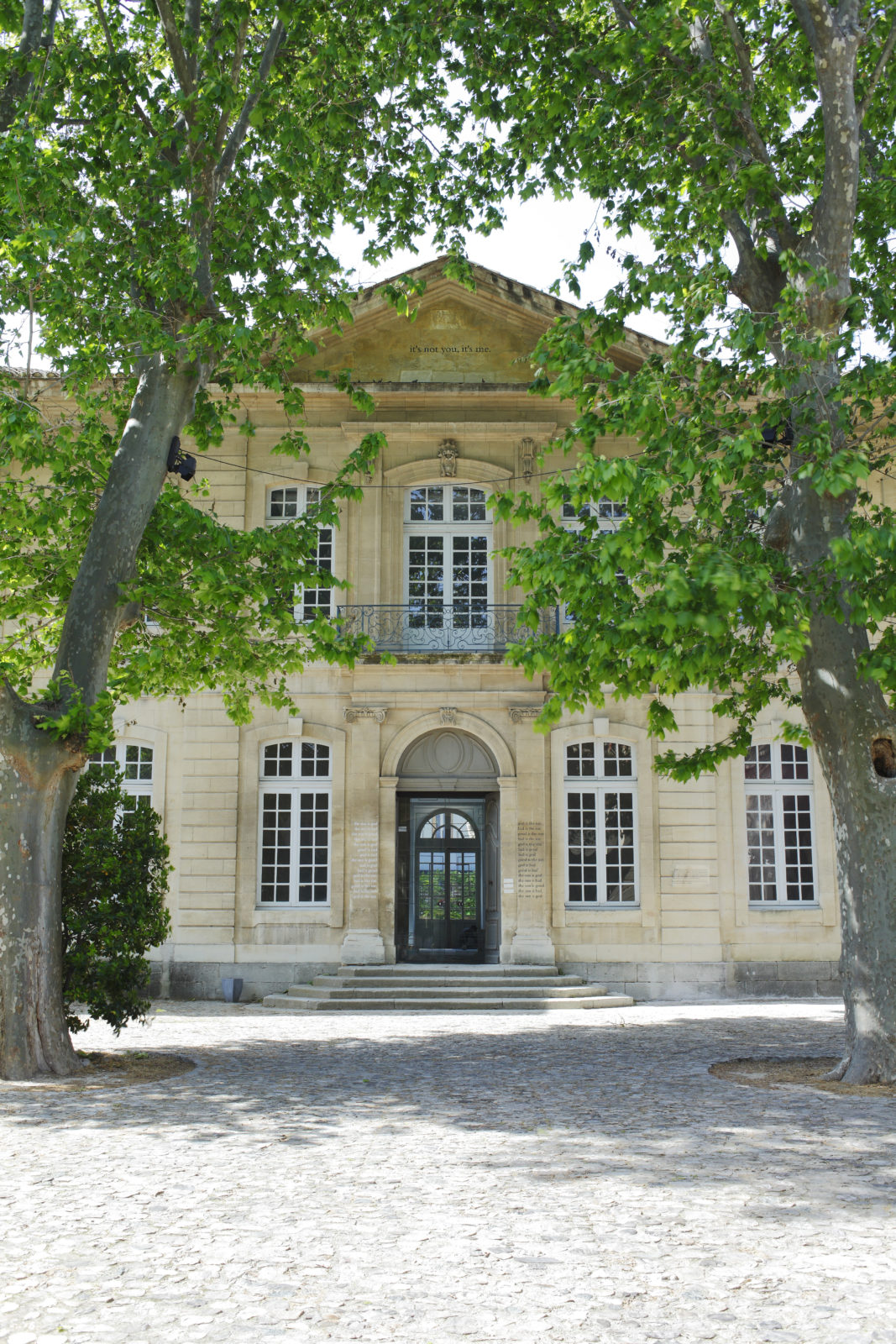

The Lambert Collection is deployed in two private mansions.
The first, the Hôtel de Caumont, was built in 1720, according to plans by Jean-Baptiste Franque, a famous architect. It was owned by Joseph de Seytres, Lord of Verquières-en-Provence and Marquis de Caumont, and was considered the “most elegant hotel in Avignon”.
Next to it, a little more modest, the Hôtel de Montfaucon, first owned by the Lord of Costebelle and then by the Duke of Galéens-Gadagne, was also built from the plans of Jean-Baptiste Franque in 1751.
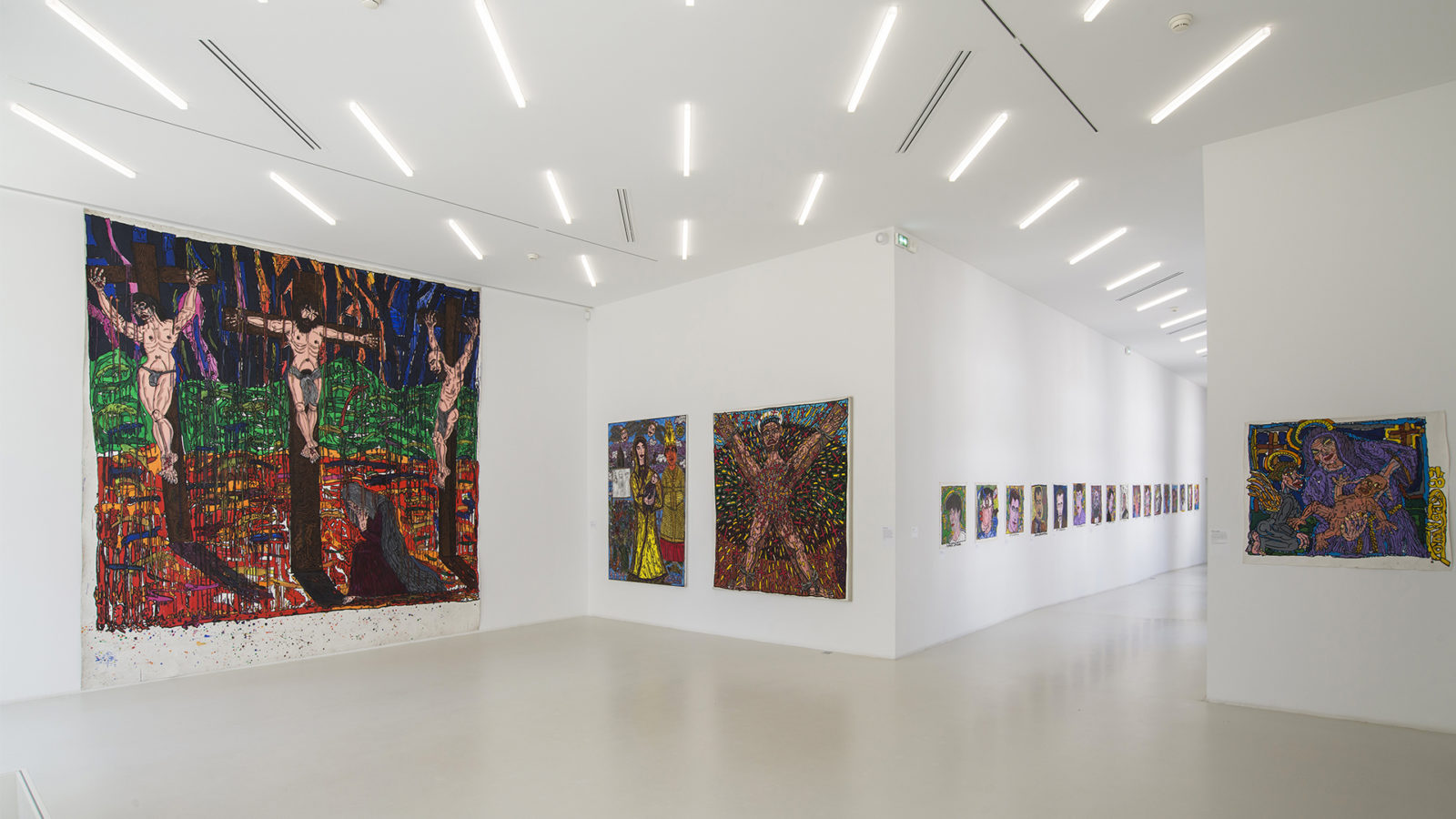
Before being a museum, the Hôtel de Caumont housed the University of Letters and was then transformed according to a museographic program followed by the architect Rudy Ricciotti.

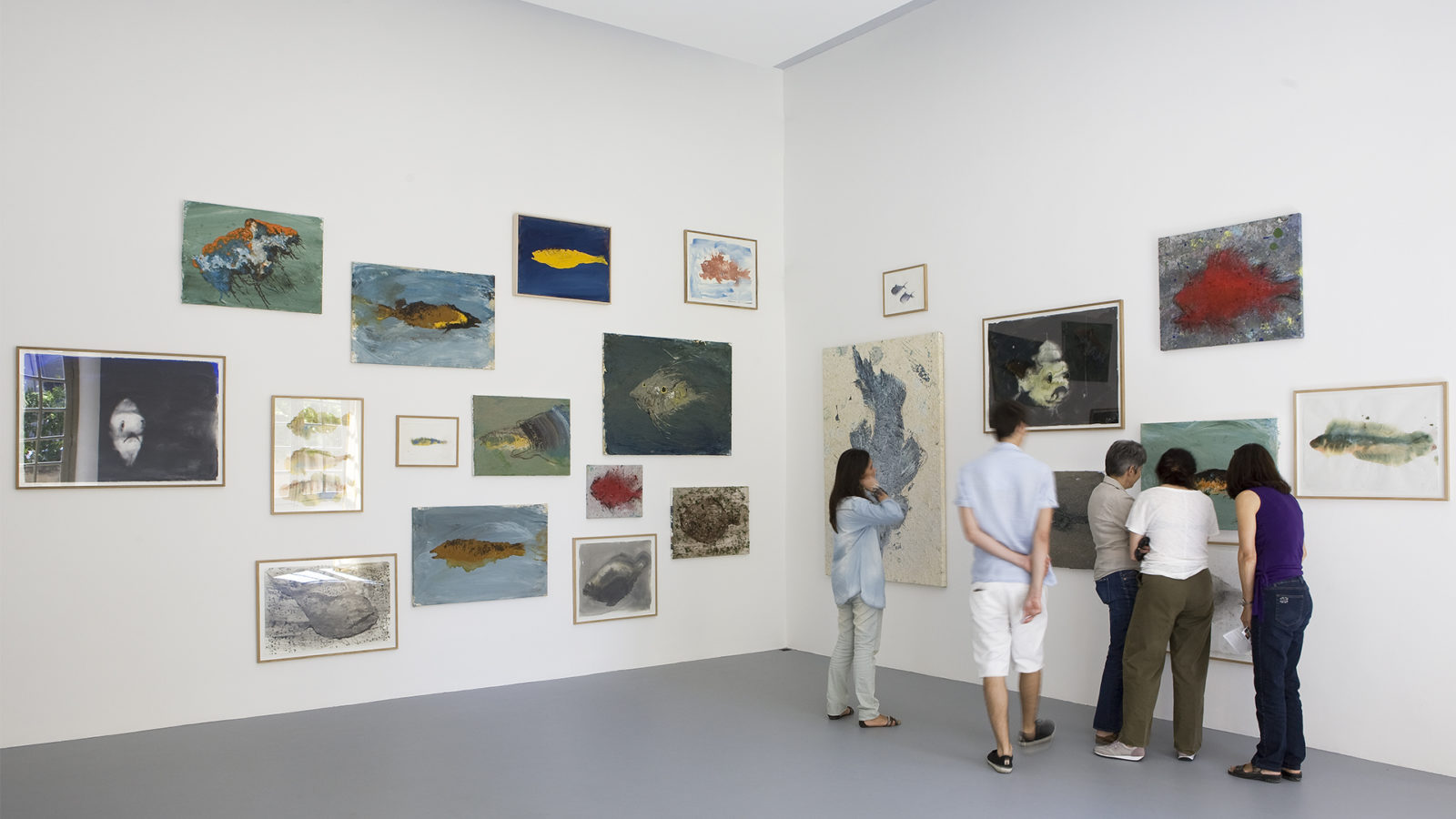

In 2015, the museum doubled its exhibition space, taking over the Hôtel de Montfaucon, the former École Supérieure d’Art d’Avignon, entirely renovated by Cyrille and Laurent Berger. The two architects redesigned this building by taking up the tradition of a white cube, but also by modulating the spaces and paying particular attention to the lights, natural and artificial, making the Hôtel de Montfaucon a showcase for the works that ‘it hosts.
Did you know? #2
Why war in the titles of Louise Lawler’s photographs?
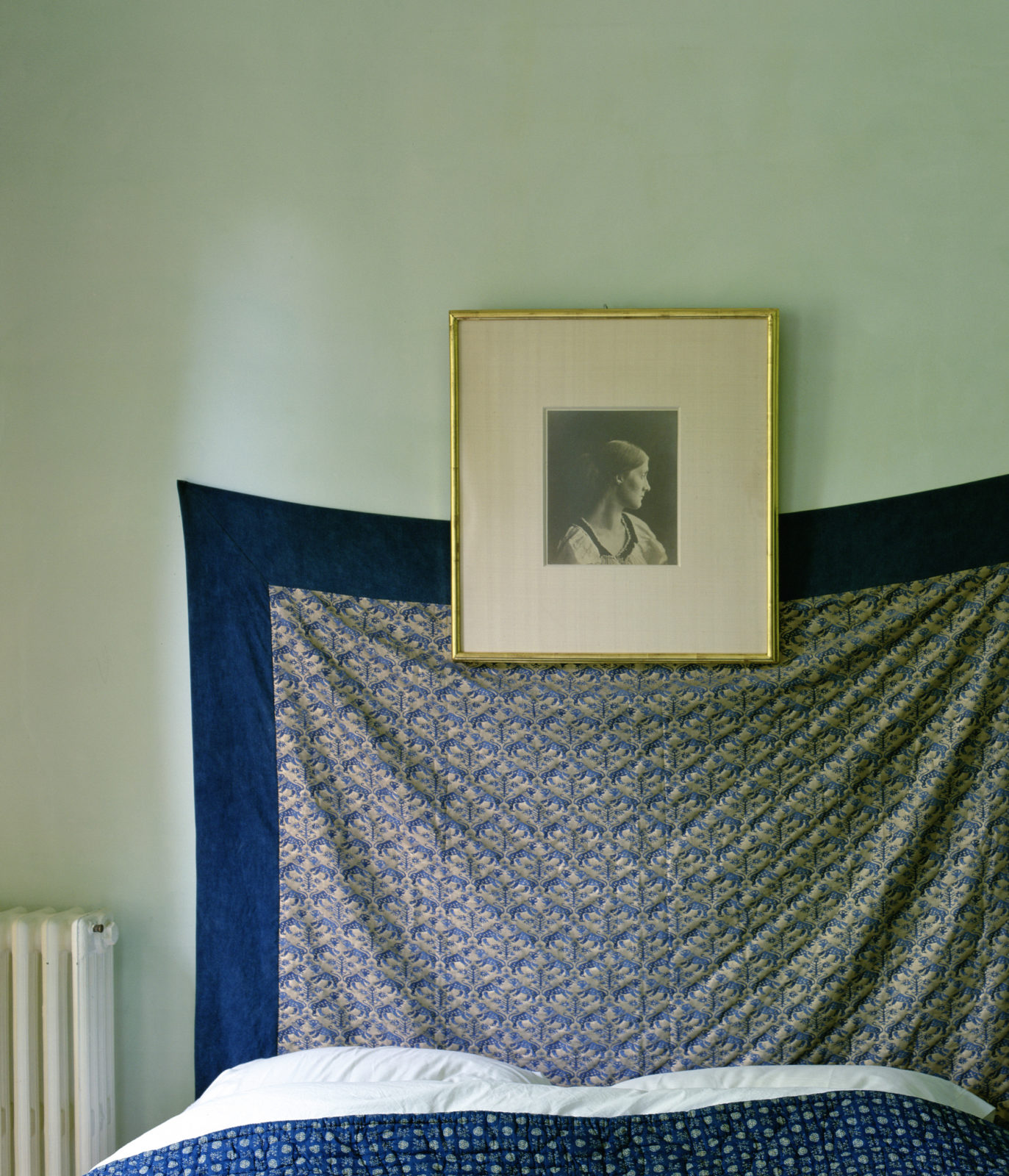
Louise Lawler, War is Terror, 2003
Collection privée Paris
© Julia Margaret Cameron / Metro Pictures, New York
If you read the titles of some photographs by American artist Louise Lawler taken in the Lambert Collection, you will notice that they refer to war: Drop Brush, not Bomb or War is Terror. None of the images, however, deal with violent events. As always, Louise Lawler takes photographs of works by other artists in their exhibition context. Here we discover a Wall drawing of Sol LeWitt in the Hôtel de Caumont or a photograph of Julia Margaret Cameron in a private interior near Avignon.
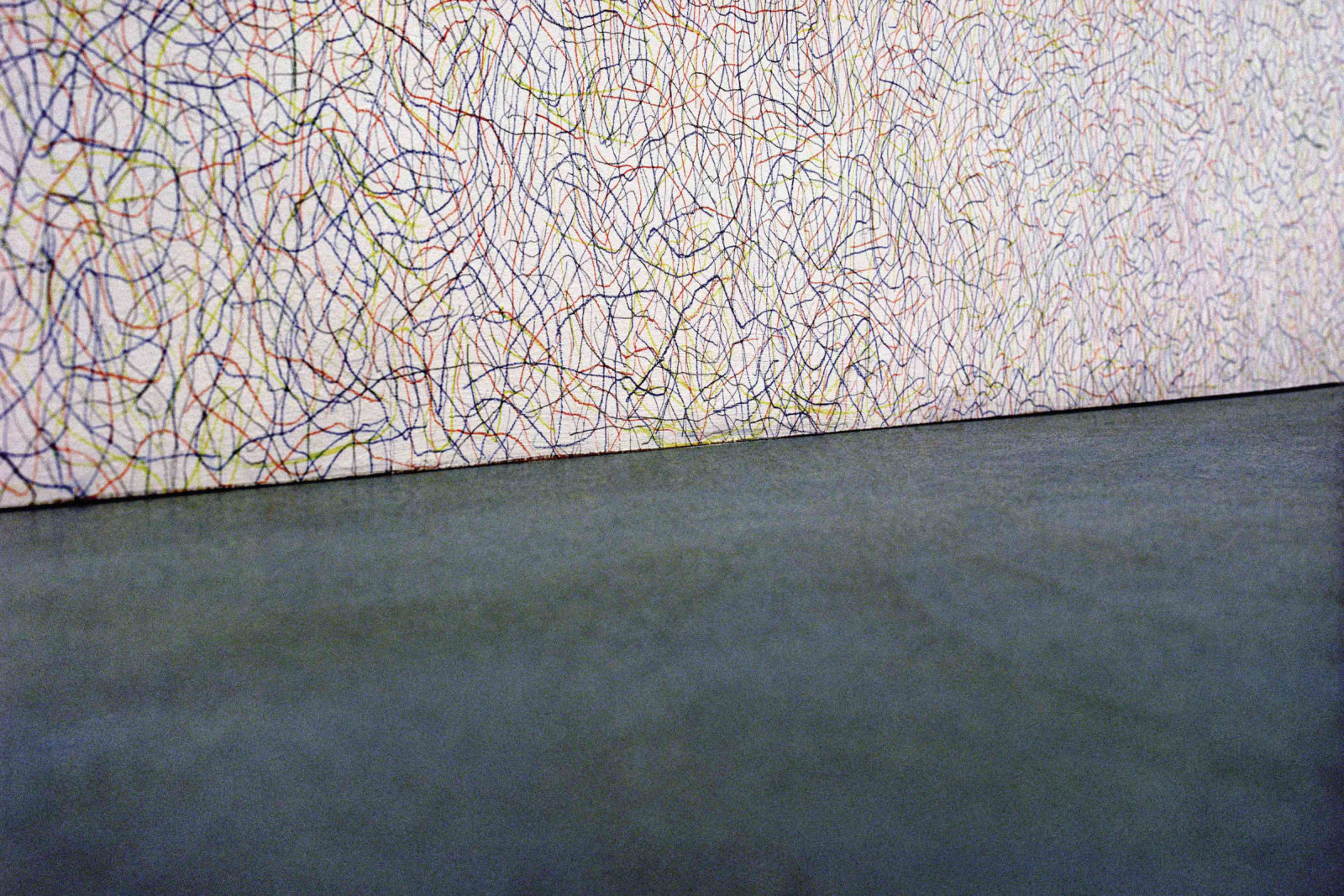
It was actually the news that led the artist to mention war in his titles. We are in the aftermath of September 11, 2001. The Twin Towers have just collapsed, struck by two planes hijacked by terrorists. The artist is stranded in Paris, without news of his relatives and without the possibility of returning home. Yvon Lambert invited him to leave for Avignon to find rest at home and in the museum created just a year earlier. There she produced a series of photographs which she later gave to the museum, some of which bear the wounds of history in their titles …
Louise Lawler, Drop Bush not Bombs, 2001
Donation Yvon Lambert à l’État français / Centre national des arts plastiques / Dépôt à la Collection Lambert, Avignon
© Sol LeWitt / Metro Pictures, New York
Did you know ? #3
Mur chez Lambert
“Mur chez Lambert” is one of the major pieces of the museum. In 1973, the artist Brice Marden chooses a wall in the apartment of his gallery owner, then realizes the work with the dimensions of the wall during one month, directly on the spot, for the greatest pleasure of Yvon Lambert who finds the artist each evening and soaks in the scent of paint and wax, becoming a privileged witness to the creation of the work. It is a triptych made of panels painted in oil and wax, in gray, brown, green colors.
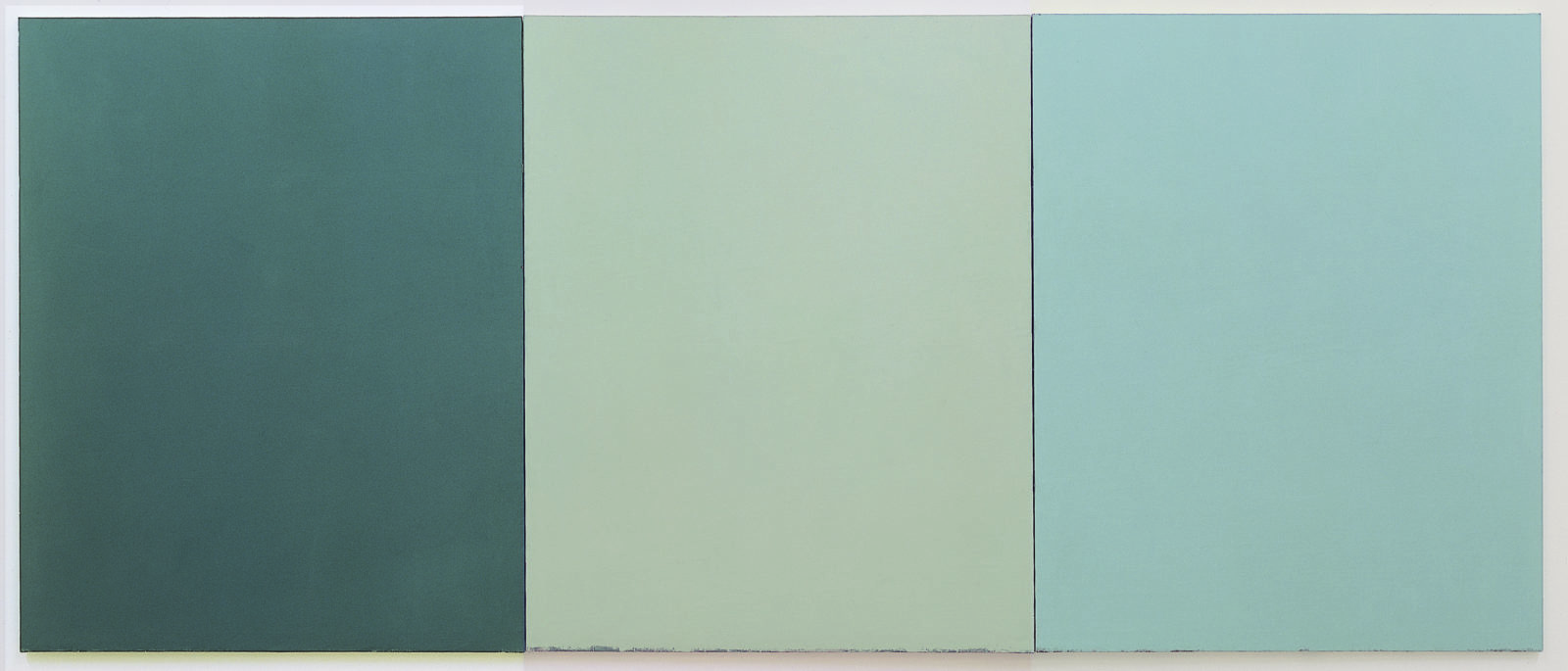
The work “bears the trace of a quantity of thickness of paint and wax, passed with a very flexible knife, which give it its sensuality” but also an incredible transparency and dullness.
Brice Marden, Mur chez Lambert, 1973
© Donation Yvon Lambert à l’État français / Centre national des arts plastiques / Dépôt à la Collection Lambert, Avignon
Did you know? #4
Andres Serrano
The famous photographer Andres Serrano was the first artist to be able to enter the Chapelle du Rosaire (or Chapelle Matisse) in Vence to work there in 2015. He produced one of his most beautiful series on religion, exhibited as part of the exhibition So be it, the same year. He had already been one of the first artists for nearly 50 years to enter the famous Comédie Française to paint a portrait of the troupe on the occasion of a public commission initiated by the Lambert Collection, which has one of the funds the most important collections in the world of works by the artist with more than 200 photographs.

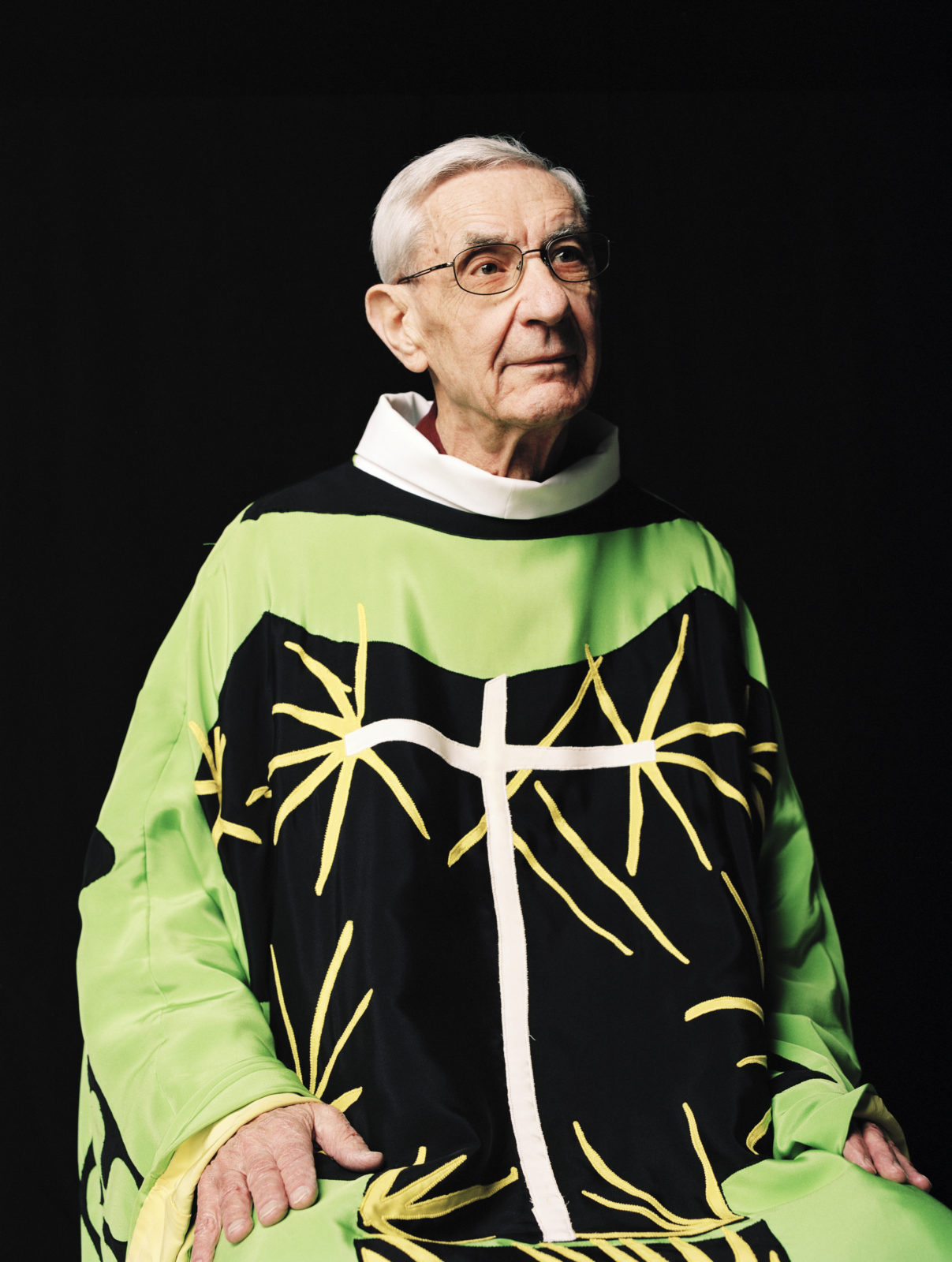
Through his photographs which he produces in the form of series and which recall the beauty and the power of classical paintings, the artist questions contemporary society in its darkest: violence and domination, poverty, death, our relationships with the body and with sex or religion, without any taboo.

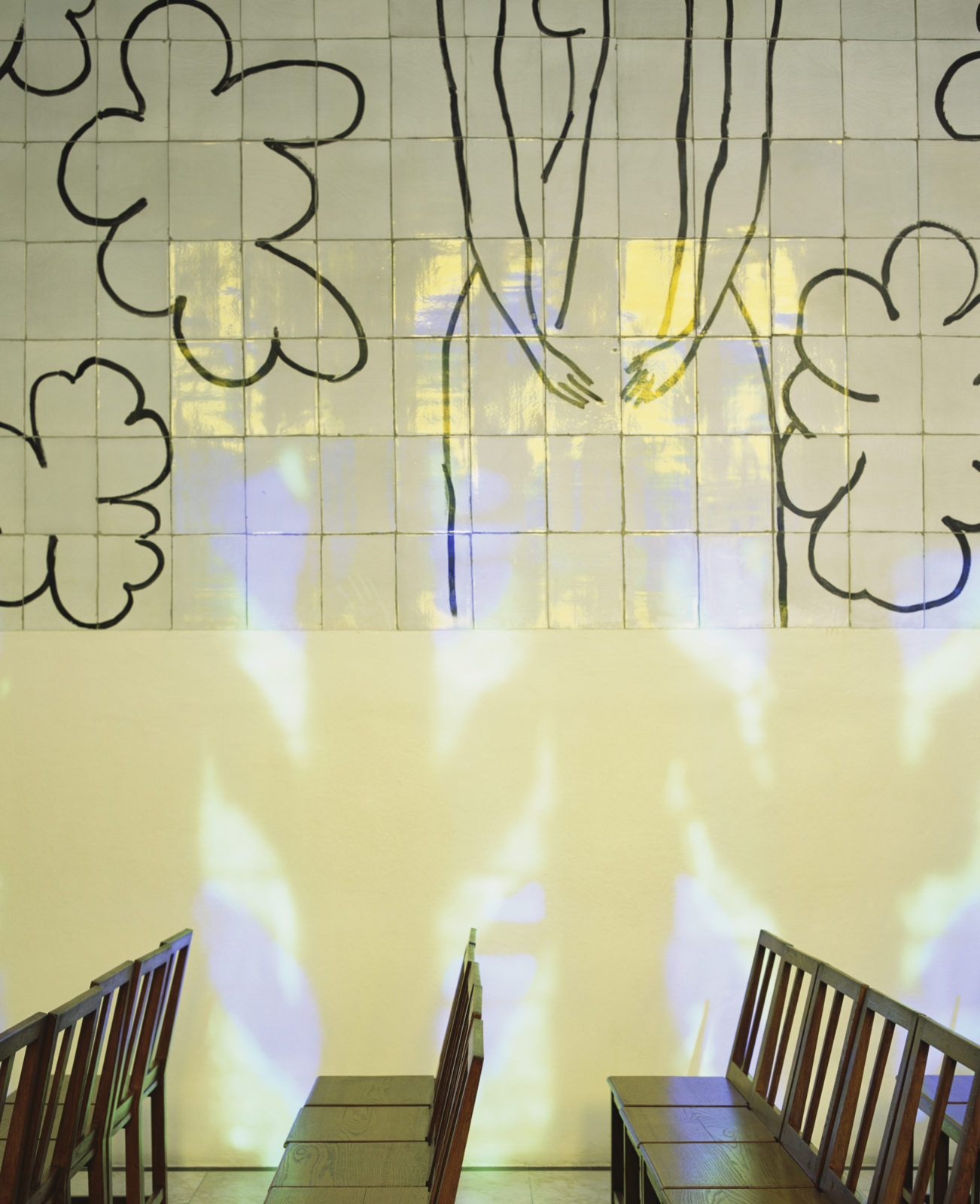
Andres Serrano, Matisse Chapel, 2015
© Collection Privée / Dépôt à la Collection Lambert, Avignon
Andres Serrano, Father Trobatas, 2015
© Collection Privée / Dépôt à la Collection Lambert, Avignon
Andres Serrano, Yellow, Blue, Green, 2015
© Collection Privée / Dépôt à la Collection Lambert, Avignon
Andres Serrano, Reflections on the Wall, 2015
© Collection Privée / Dépôt à la Collection Lambert, Avignon
Did you know? #5
The work Blue Moon III was donated to the museum by artist Kiki Smith after the exhibition “The Papesses” in 2013. American artist of German origin, Kiki Smith belongs to the second wave of female artists who influenced the current feminist demands since 1970.
Born from his dreams, the artist’s poetic and delicate works evoke nature, the body, the animal world and relationships with man, religious and cosmological mythology.
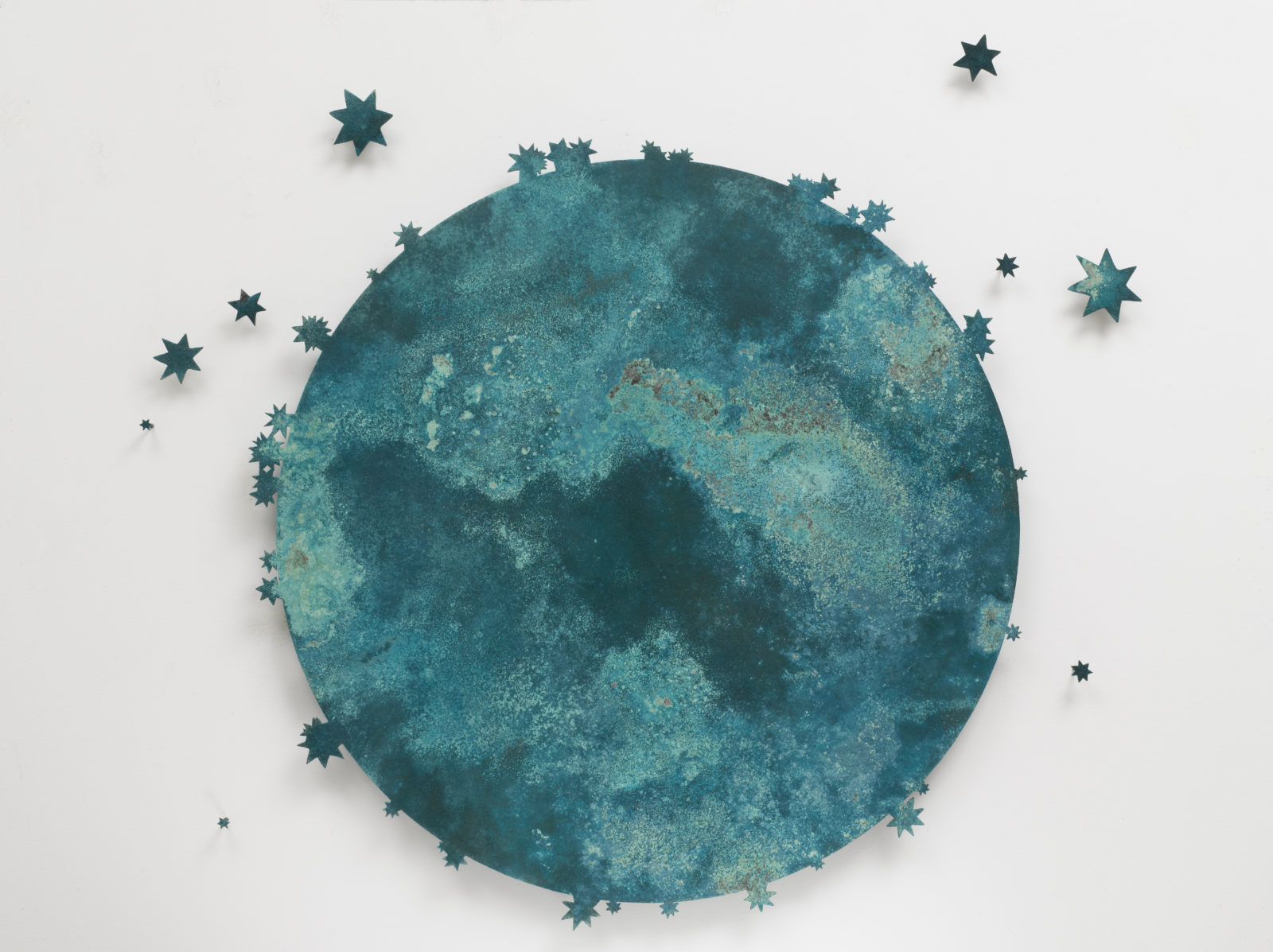
This blue moon, surrounded by blue stars, symbols of protection for the artist, testifies to this rare phenomenon when an additional full moon appears, every two or three years. The moon does not wear this blue color so far, but the term “blue moon” is used in English to describe a very rare event.
Kiki Smith, Blue Moon III, 2011
© Collection Lambert, Avignon
Did you know? #6
The work La Montagne Sainte-Victoire by Giulio Paolini pays tribute to Paul Cézanne, painter in love with this mountain near Aix-en-Provence. Italian artist and founder of Arte Povera, Giulio Paolini decomposes painting in this installation where several elements and pieces of wood form a tangle of geometric structures: rectangle, square, line. The artist chooses to keep only the traditional tools of the painter of yesterday: frames, two easels, a white canvas. The empty frames crop and frame a blank canvas, leaving the composition to guess the mountain in perspective.
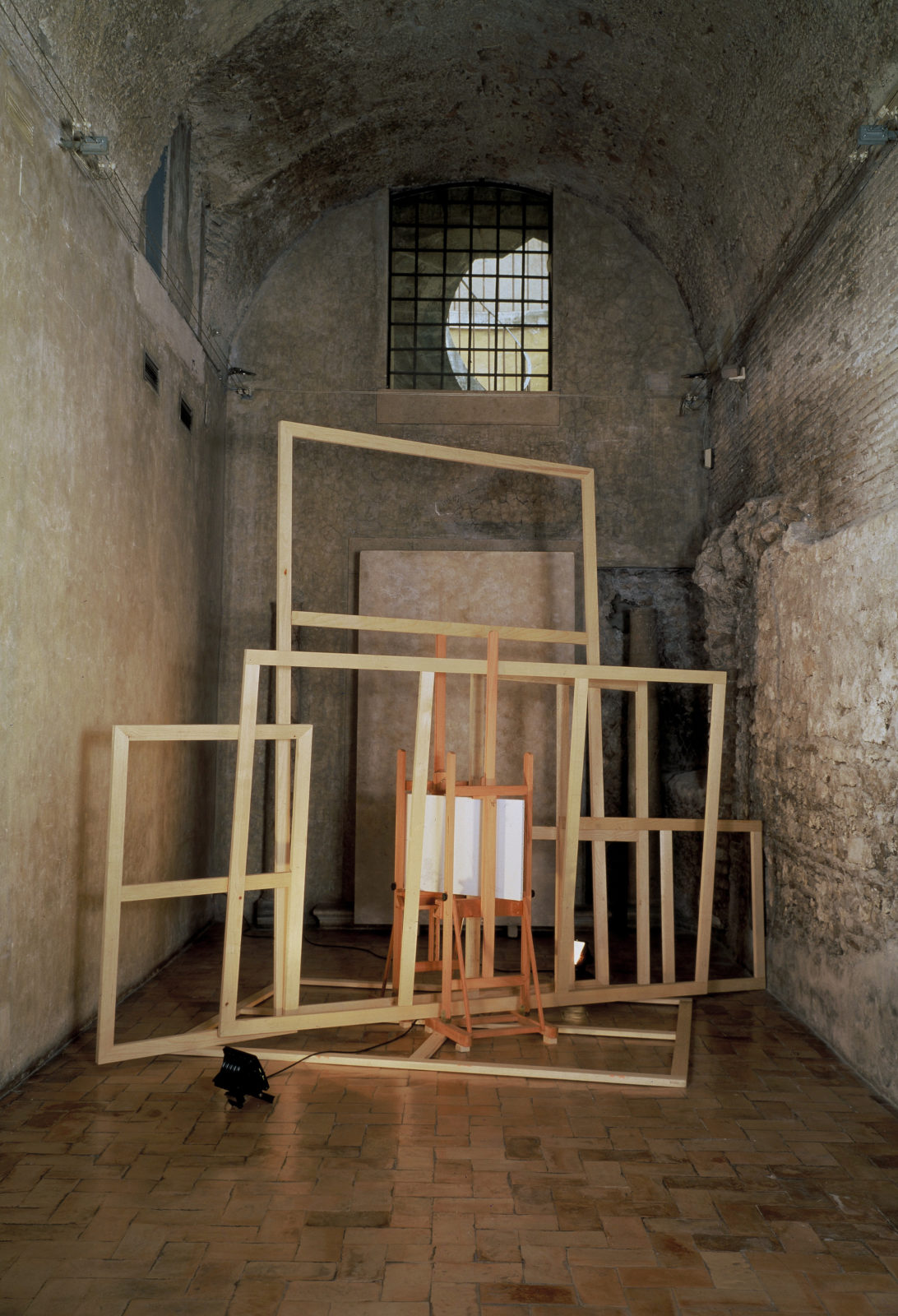
Giulio Paolini, La montagne Sainte-Victoire, 1995
© Donation Yvon Lambert à l’État français / Centre national des arts plastiques / Dépôt à la Collection Lambert, Avignon
Did you know? #7
It is by discovering for the first time the work of Claire Fontaine, Foreigners Everywhere installed in Sainte-Anne prison during the exhibition “The disappearance of the Fireflies”, that the members of the Friends association from the Lambert Collection have decided to acquire it for the museum; as a souvenir of this project, as poetic as it is pharaonic, which welcomed no less than 80,000 visitors in 2014.

The Claire Fontaine collective mixes all types of possible mediums, but often the simplicity of the materials used contrasts with the force of the message, here as current as it is essential. Their work questions among others contemporary society, politics, violence.
This neon written in Arabic and Hebrew was designed for the Sainte Marthe district in Paris – a crossroads of populations where several communities mix – and has been translated into around twenty languages spoken in the district: Arabic, Chinese, Creole, Hebrew , Italian…

Claire Fontaine, Foreigners Everywhere (Arabic/Hebrew), 2010
© Collection Lambert, Avignon
Crédits photo : Pascal Martinez
Did you know? #8
Žilvinas Kempinas
Lithuanian artist Žilvinas Kempinas has produced one of the most enchanting works in the museum. Interested in kinetic art from the 1960s, he questions and experiments with the question of movement in art.
For this, the artist goes to the basics and uses few materials: an industrial fan installed on the ceiling and a magnetic strip which undoubtedly undulates and creates a plastic universe where random shapes are drawn in space. Oasis, the poetic title of the work, invites each visitor into a moving and mysterious world.

Žilvinas Kempinas, Oasis, 2009
© Donation Yvon Lambert à l’État français / Centre national des arts plastiques / Dépôt à la Collection Lambert, Avignon
Le saviez-vous ? #9
Mircea Cantor
Romanian artist Mircea Cantor produced Another message in 2000, after taking up the LOVE symbol imagined by artist Robert Indiana in the 1960s, symbolically taken up by AIDS in the 1990s.
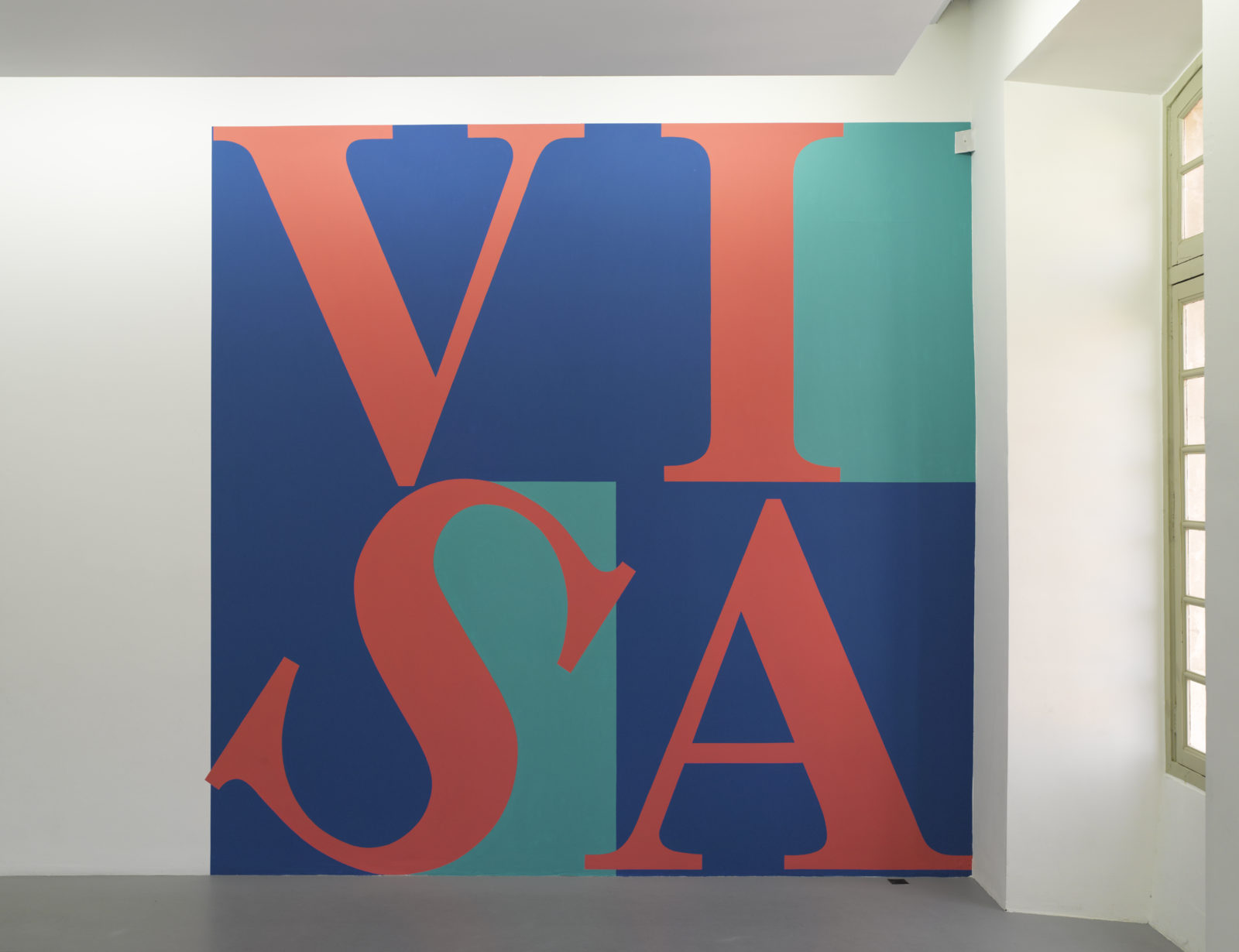
Like a pop and tangy logo, Mircea Cantor brings through this work a fine critique of contemporary society, a reflection on the positive and negative aspects of globalization. The VISA mural depicts the situation of travelers without paper, without a residence permit or visa, thus telling the news.
The artist very often places himself at the crossroads of worlds and allows rapprochements of mentalities, as an attentive witness to society and cultures.
Mircea Cantor, Another message, 2000
Crédit photo : François Deladerrière
© Donation Yvon Lambert à l’État français / Centre national des arts plastiques / Dépôt à la Collection Lambert, Avignon


Cy Twombly, Pan, 1980
“Cy Twombly has the same passion as me for mythology. We have the same way of approaching these stories where the fate of humans is subject only to the whims of the gods and goddesses, not as scholars but with an instinctive connection between all the eras of art history.”
“To escape Pan’s sexual assaults, the nymph Syrinx fled near a river and metamorphosed into a reed. Pan picked a handful and made it the musical instrument that bears his name. Is it then the idea of the seven notes that make up the range of western music that Cy reinterpreted by dividing this sublime work into seven pieces united by the overflows of his creative energy?”
Cy Twombly
Pan, 1980
© Donation Yvon Lambert à l’État français / Centre national des arts plastiques / Dépôt à la Collection Lambert, Avignon
Nan Goldin, Self-Portrait (All by myself), 1995
“It would be impossible for me to say how many times I have seen Nan’s slideshow, All by Myself. With the very moving song of Eartha Kitt Beautiful at Forty who assumes her age by scrutinizing her past without nostalgia, Nan had found there the most beautiful musical medium to make time unfold through the 95 images which constitute her almost testamentary self-portrait.
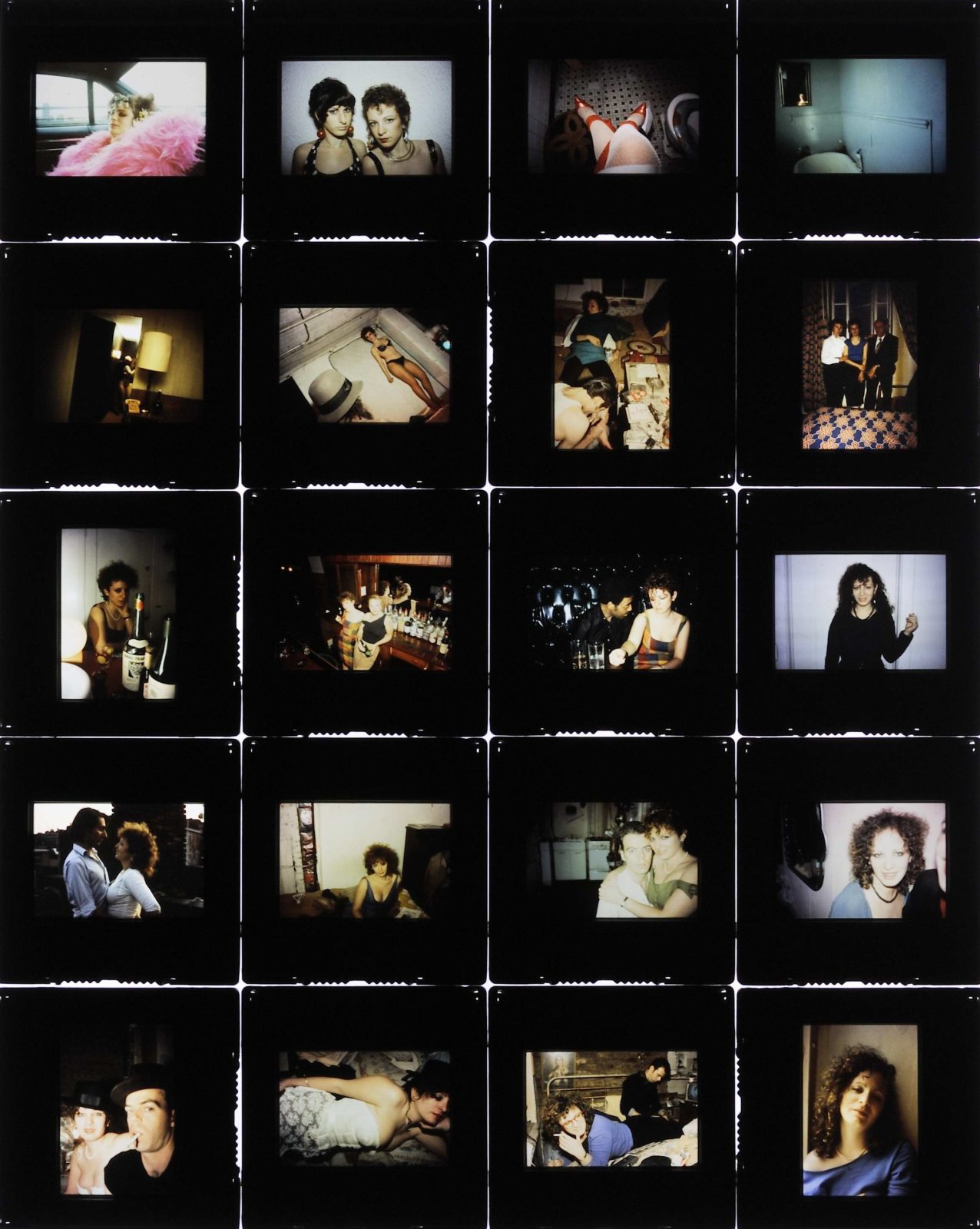
(…) Like all his slideshows, this one is unique, the choice of slides and their order was specially designed for me.”
Nan Goldin, Self-Portrait (All by myself), 1995
© Donation Yvon Lambert à l’État français / Centre national des arts plastiques / Dépôt à la Collection Lambert, Avignon
Niele Toroni, Empreintes de pinceau n°50 à intervalles réguliers (30 cm), 1983
“If I have to characterize Niele Toroni, it is without hesitation her loyalty that immediately comes to mind. Faithful in friendship because I share his artistic adventure and his epicurean side for more than thirty years, faithful in his work because I do not know other artists who have followed like him the same path without ever turning away from the goal.”
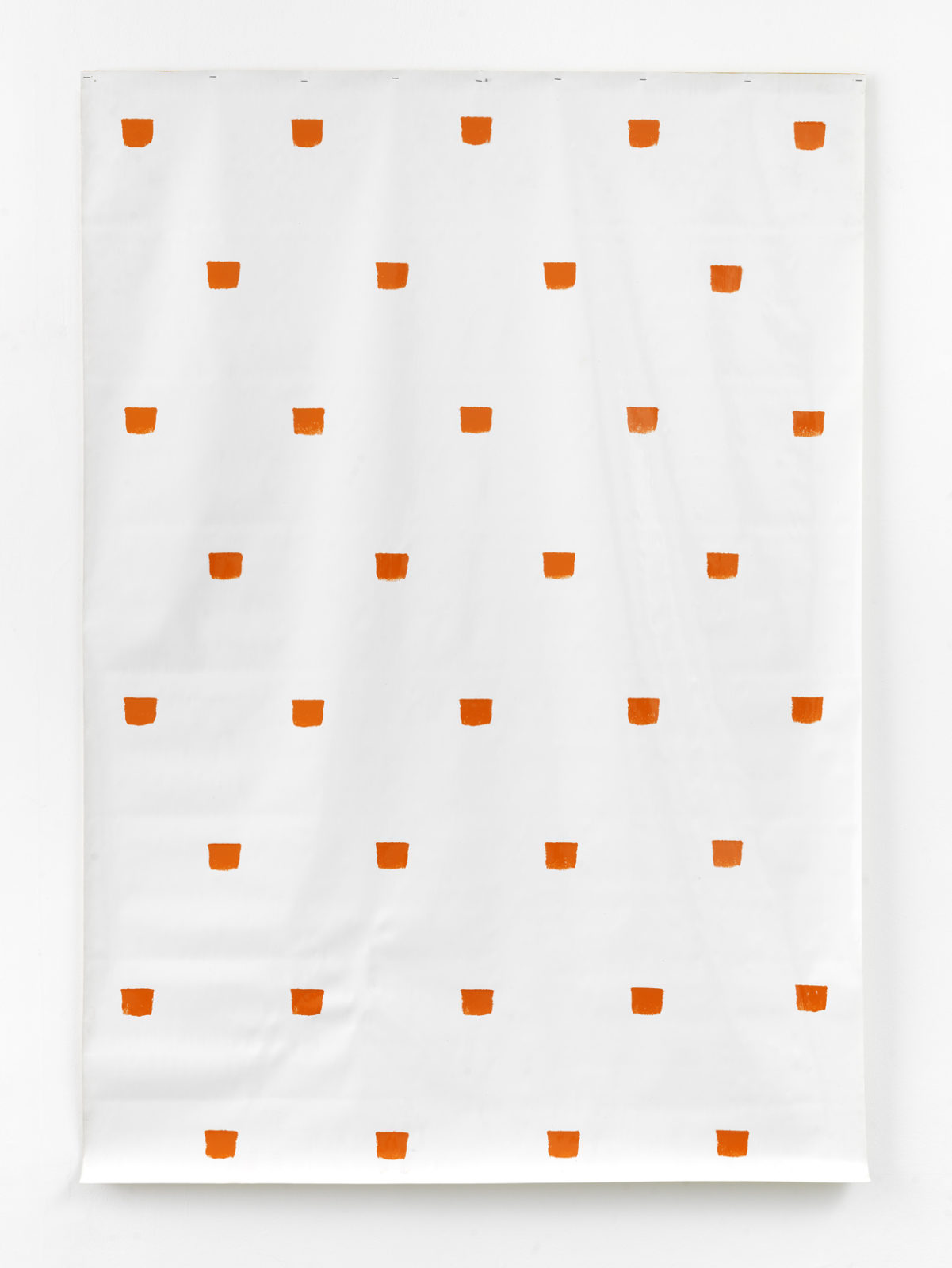
“His footprints have become the coats of arms of which one seems the armor of knights so that they are recognizable in battles. By themselves, they sign a gesture, an act and identify the author.”
Niele Toroni, Empreintes de pinceau n°50 à intervalles réguliers (30 cm), 1983
© Collection Privée / Dépôt à la Collection Lambert, Avignon
Miquel Barcelo, Biblioteca, 1984
“Some of Miquel Barceló’s works are so associated with my passions that they seem to have been created especially for me or stem from our passionate discussions in his studio.

(…) The works that touch me the most are linked to a theme he often took up at that time, that of a character in his library who reminds me of the stacks of books and catalogs that I pile up all over my reserve and my apartment.”
Miquel Barceló, Biblioteca, 1984
© Donation Yvon Lambert à l’État français / Centre national des arts plastiques / Dépôt à la Collection Lambert, Avignon
Marcel Broodthaers, Bouteille à la mer, 1970-1971
“Marcel Broodthaers loved Baudelaire and Mallarmé like me, and spoke of art with an irony that I have never found in other artists. He approached the art and money market in particular with incredible derision, but this cynicism always indicated a great relevance as to how to analyze our time.”
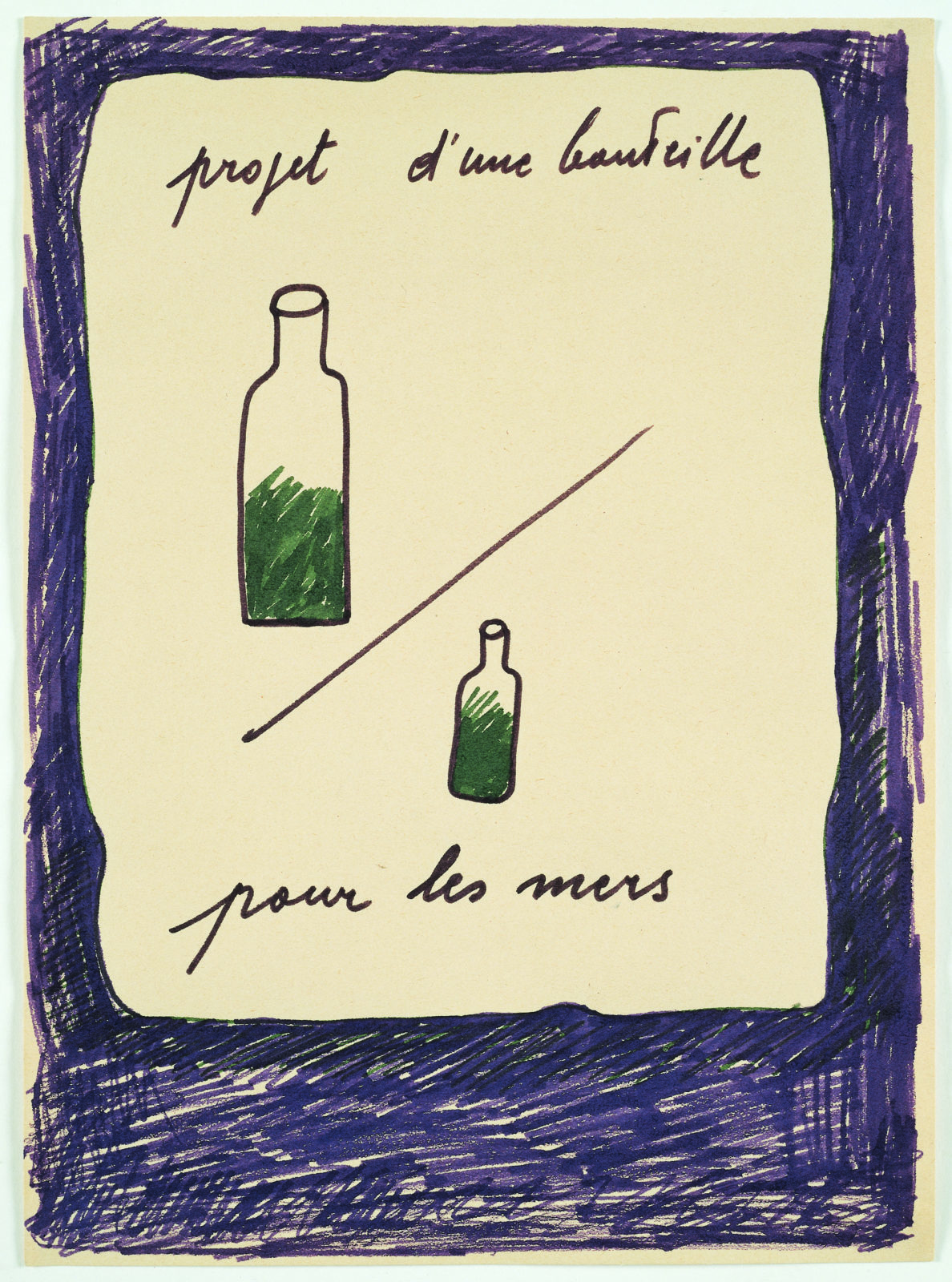
Marcel Broodthaers, Bouteille à la mer, 1970-1971
© Donation Yvon Lambert à l’État français / Centre national des arts plastiques / Dépôt à la Collection Lambert, Avignon
Robert Ryman, Sans titre (Surface Veil), 1970
“A very small Ryman, four pieces of scotch tape stuck on tracing paper. It is a small thing of nothing, but for me it is the most beautiful homage which is paid to painting in its simplicity.”

Robert Ryman, Sans titre (Surface Veil), 1970
© Collection privée, Paris / Dépôt à la Collection Lambert, Avignon
© Robert Ryman
Richard Serra, Equal Rectangles, 1986
“In 1990, I finally realized an exhibition of Richard. Two enormous canvases coated with this heavy black material so plump fell to the ground. It was a spectacle of great strength that reminded me of these images so vivid in my memory of my first visits to his workshop. The value of time then took on a whole thickness which materialized through these monumental works.”
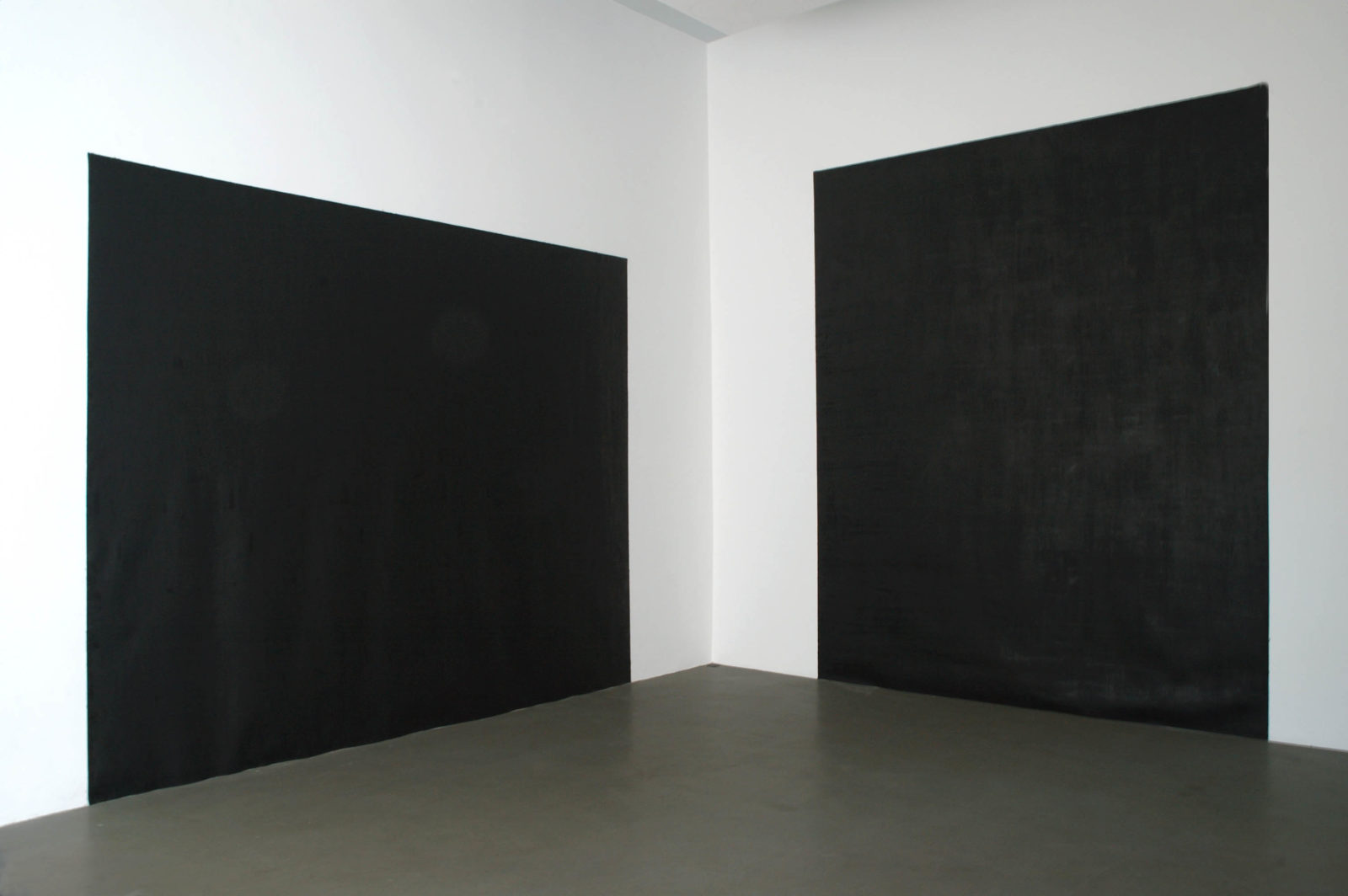
Richard Serra, Equal Rectangles, 1986
© Collection Privée / Dépôt à la Collection Lambert, Avignon
Christian Boltanski, Les Images noires, 1995
“In my opinion, this work perfectly bridges the minimal works in my collection with the more contemporary concerns of certain artists today. Indeed, the very minimal game resides in this set of monochrome blacks, which recall those of Brice Marden, Allan McCollum or further back in time by Barnett Newman and Ad Reinhardt.
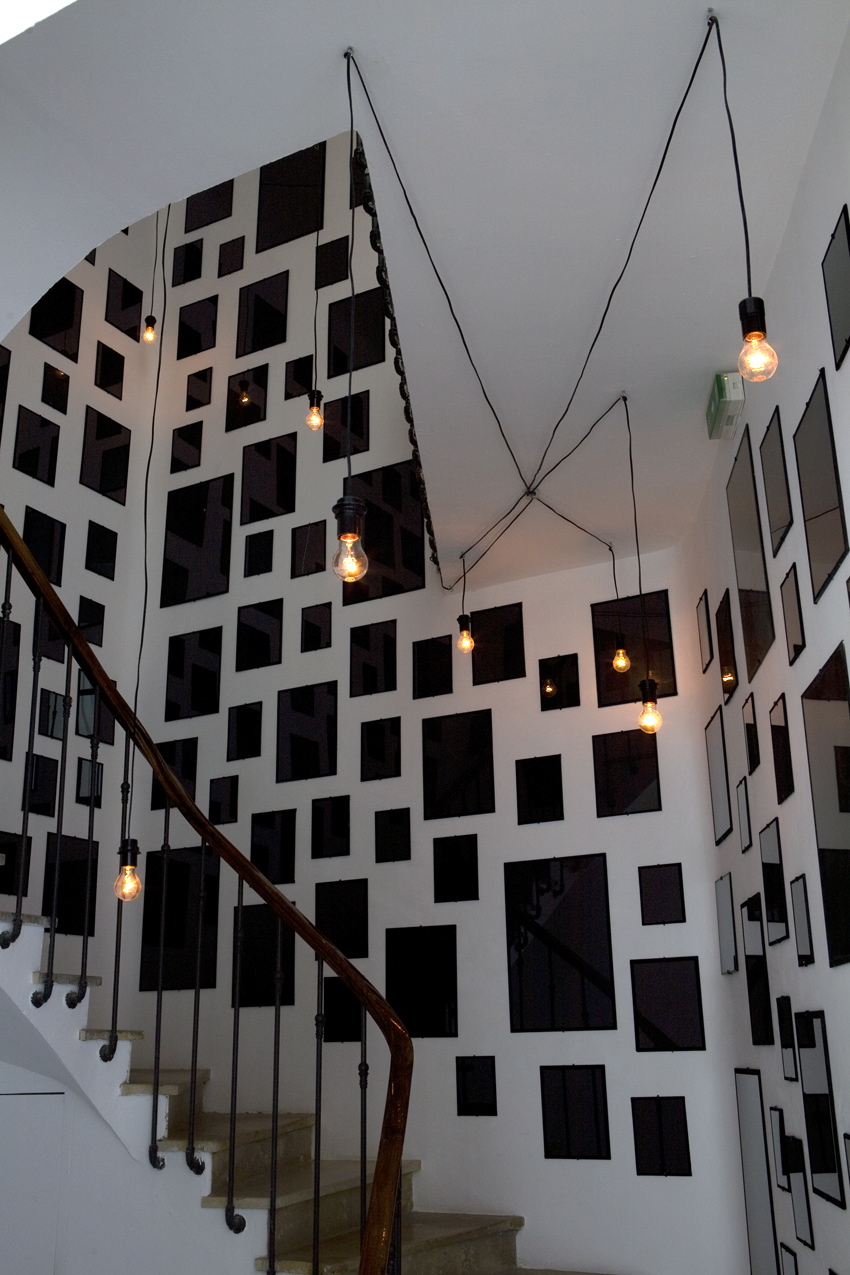
But the arrangement of these black frames evokes less the death of painting, advocated by the great masters of American Art from the end of the 1950s, than the disappearance of images as so many elements of memory that vanishes.”
Christian Boltanski, Les Images Noires, 1995
Donation Yvon Lambert à l’Etat français / Centre national les arts plastiques / Dépôt à la Collection Lambert, Avignon.
Crédit photo : Pascal Martinez
Richard Tuttle, Any Three Colors on My Mind, 1973
“It is always difficult for me to talk about Richard Tuttle as my understanding of his work comes almost exclusively from tenderness. I have loved all of his work for thirty years and I cannot say anything more. Seeing on my walls these works made of “bits of string”, of a few lines of pencils mixed with traces of brushes, I know that all this rests on almost nothing, I don’t care. It’s almost nothing so subtle that moves me so much.”
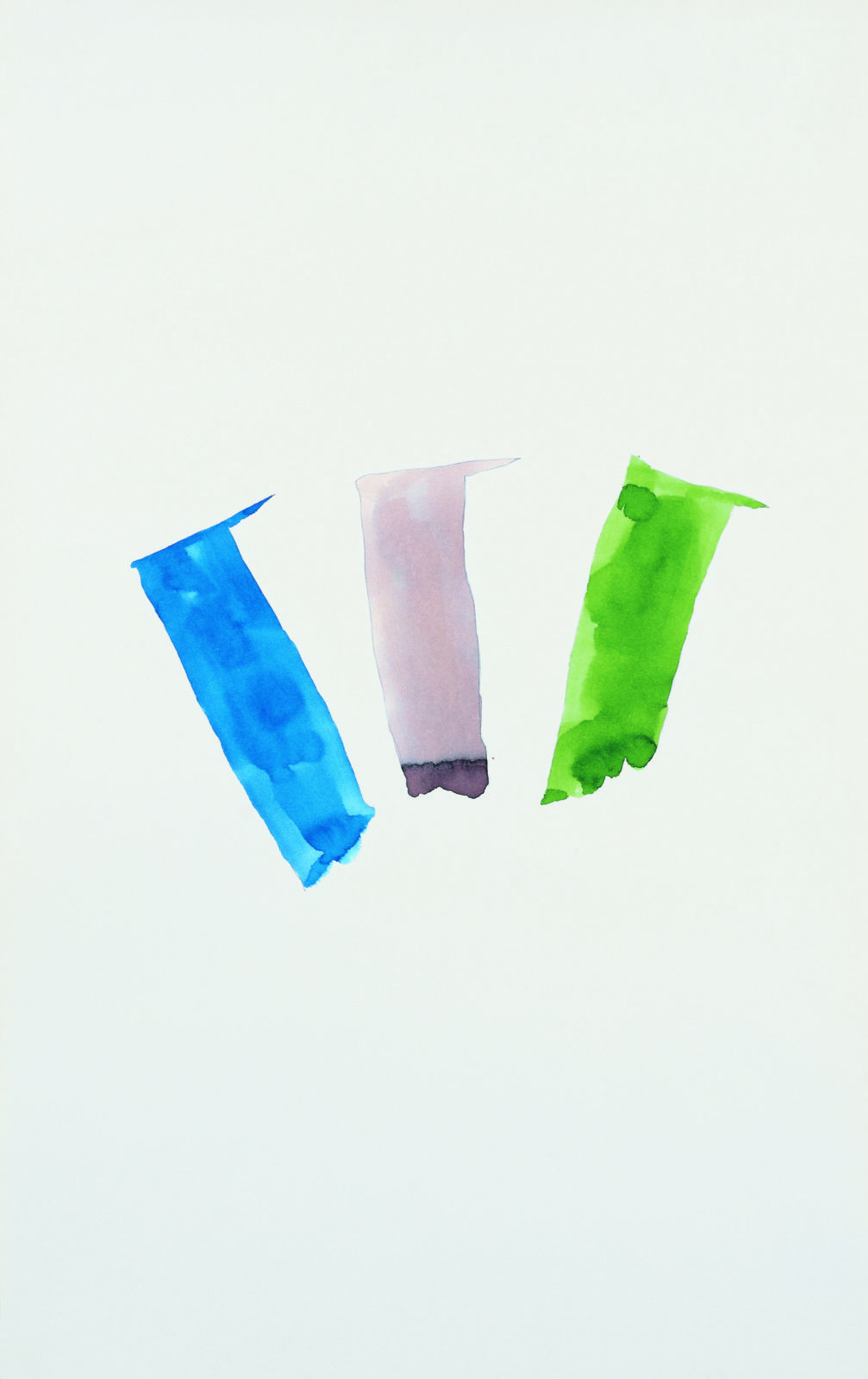
Richard Tuttle, Any Three Colors on my Mind, 1973
© Collection Privée / Dépôt à la Collection Lambert, Avignon
Robert Barry, Sans titre, 1980
“With Robert Barry, it is a work all in poetry, where the words barely written in pencil on the pictorial support act as zones of sensitivity, sometimes integrating into the composition of the work, but overflowing also from the frame set by the artist. (…) The words are there, they overflow and can extend beyond the work, in the imagination of the spectator as on white walls.”
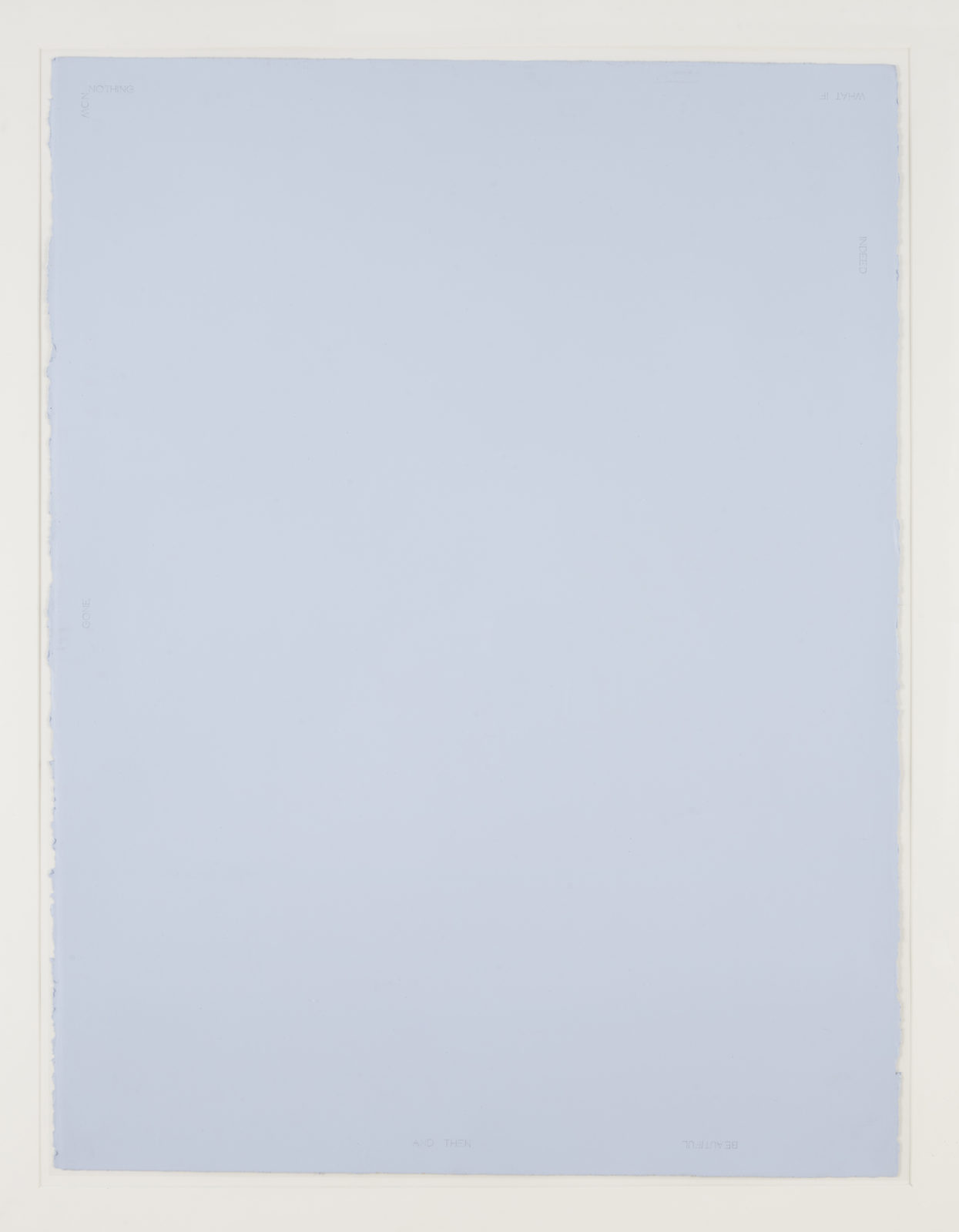
Robert Barry, Sans titre, 1980
© Donation Yvon Lambert à l’État français / Centre national des arts plastiques / Dépôt à la Collection Lambert, Avignon
Robert Combas, Enée descend aux enfers, 1988
“While my gallery was renowned for its very theoretical positions, for very radical and rather austere artistic choices, Combas represented the gaiety, the innocence associated with the bulimia of an unreflected, instinctive and impulsive work. Against the rather monochrome and refined works of my usual artists was color in all its splendor. I thus hold Robert Combas for one of the greatest colorists of his generation.”
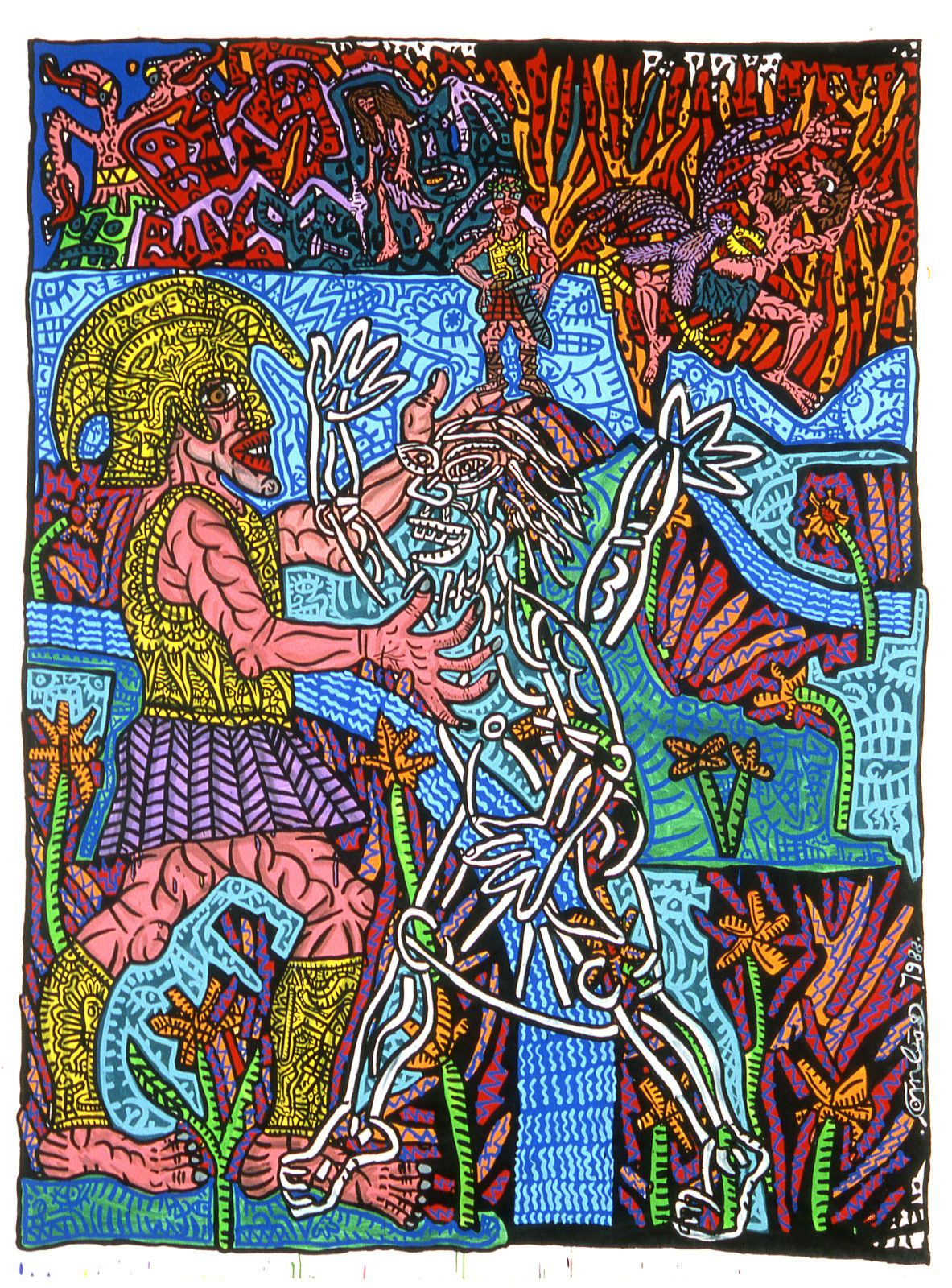
On Kawara, I am Still Alive, 1972
“The daily reception of his telegrams was the starting point of an adventure with him that lasted nearly thirty years. Every day, I was warned that a telegram would be delivered to me and after having passed the surprise of the first, I impatiently awaited the following. Yet all were similar, with this litany at the same time so ironic for some but for me so moving “I am still alive”? I was of course aware that this series of messages already constituted a work in its own right, but what I liked so much in this sending, it was from a personal point of view the encouragement so strong that these telegrams aroused in me.”
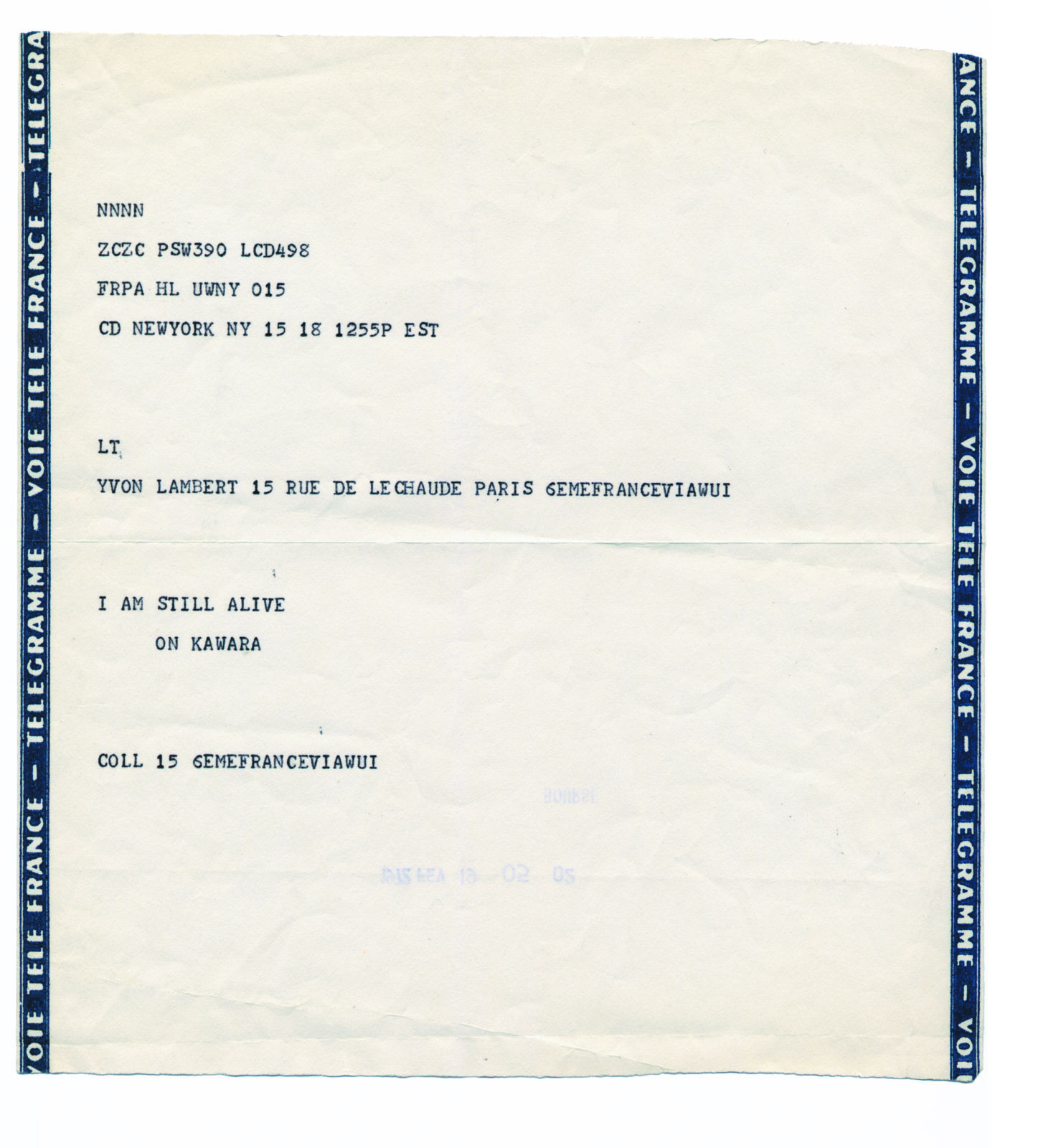
On Kawara, I Am Still Alive, 1972
© Donation Yvon Lambert à l’État français / Centre national des arts plastiques / Dépôt à la Collection Lambert, Avignon
Bruce Nauman, I Have Quick Hands, 1974
“Is it by my self-taught side and my lack of theoretical training in my youth, I always chose to defend an artist and to love his work if it responded to my emotional and sensual appetite more than to a cerebral jubilation. I didn’t need anyone to convince me to bet on my most radical artists, for me, it’s still, even today, the idea of launching without thinking about a great adventure that dictates my steps.”
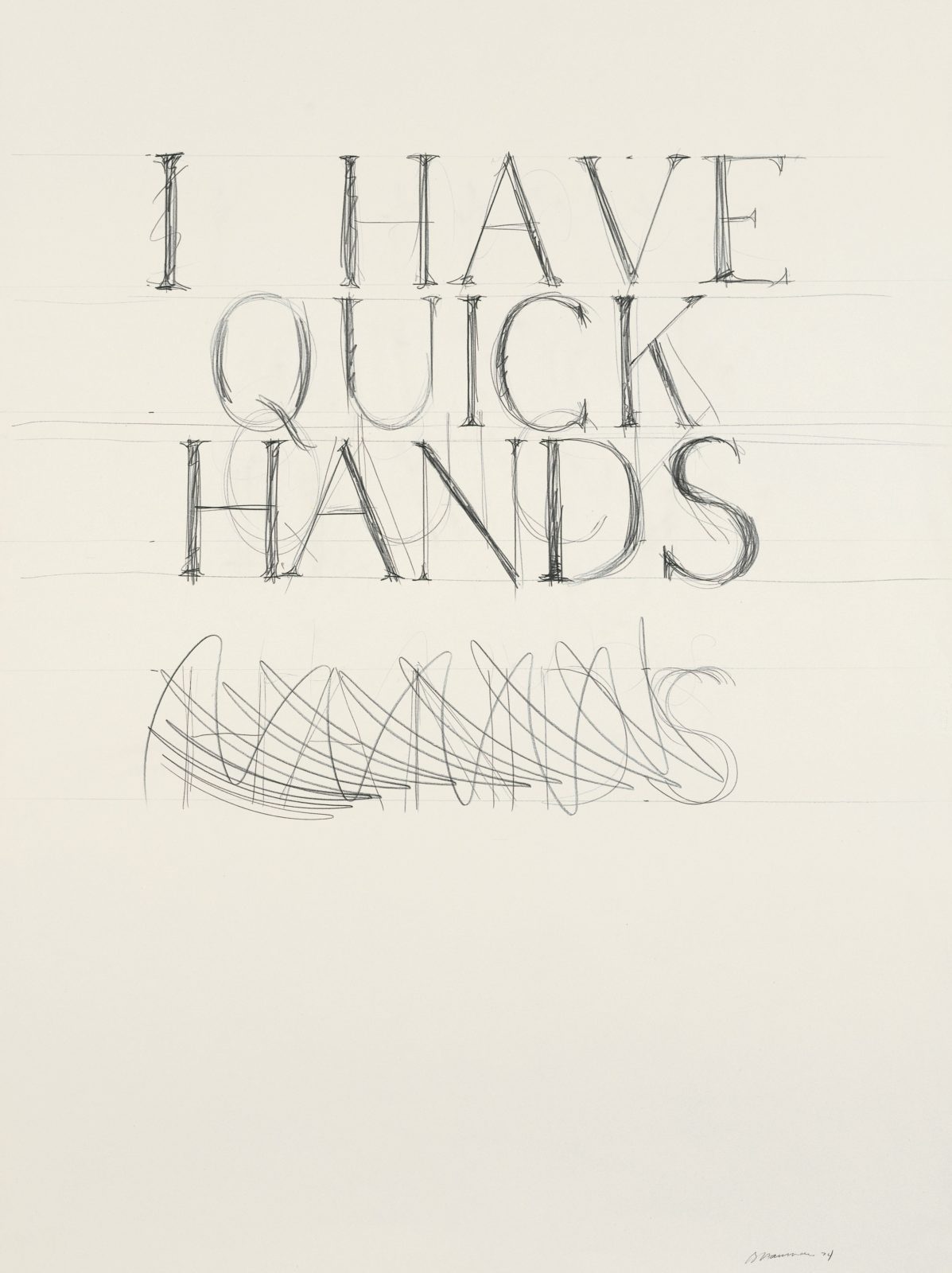
Bruce Nauman, I Have Quick Hands, 1974
© Donation Yvon Lambert à l’État français / Centre national des arts plastiques / Dépôt à la Collection Lambert, Avignon
Anselm Kiefer, Cette obscure clarté qui tombent des étoiles, 1996
“For Cette obscure clarté qui tombe des étoiles, I saw Anselm sow thousands of sunflower seeds in the fields, photograph the flowers under the September sun, dry them in the workshop and then use them as raw materials, constitutive of the work. In turn, sunflowers have become trees of life in the most recent self-portraits; by taking root directly in the belly of the artist, they also served for incredible cosmogonies where each black seed symbolizes the stars of a learned solar system. They are declined around this sublime verse of Corneille, this great playwright of the 17th century. It is French culture in all its elegance that Anselm Kiefer brilliantly integrated into this work. “
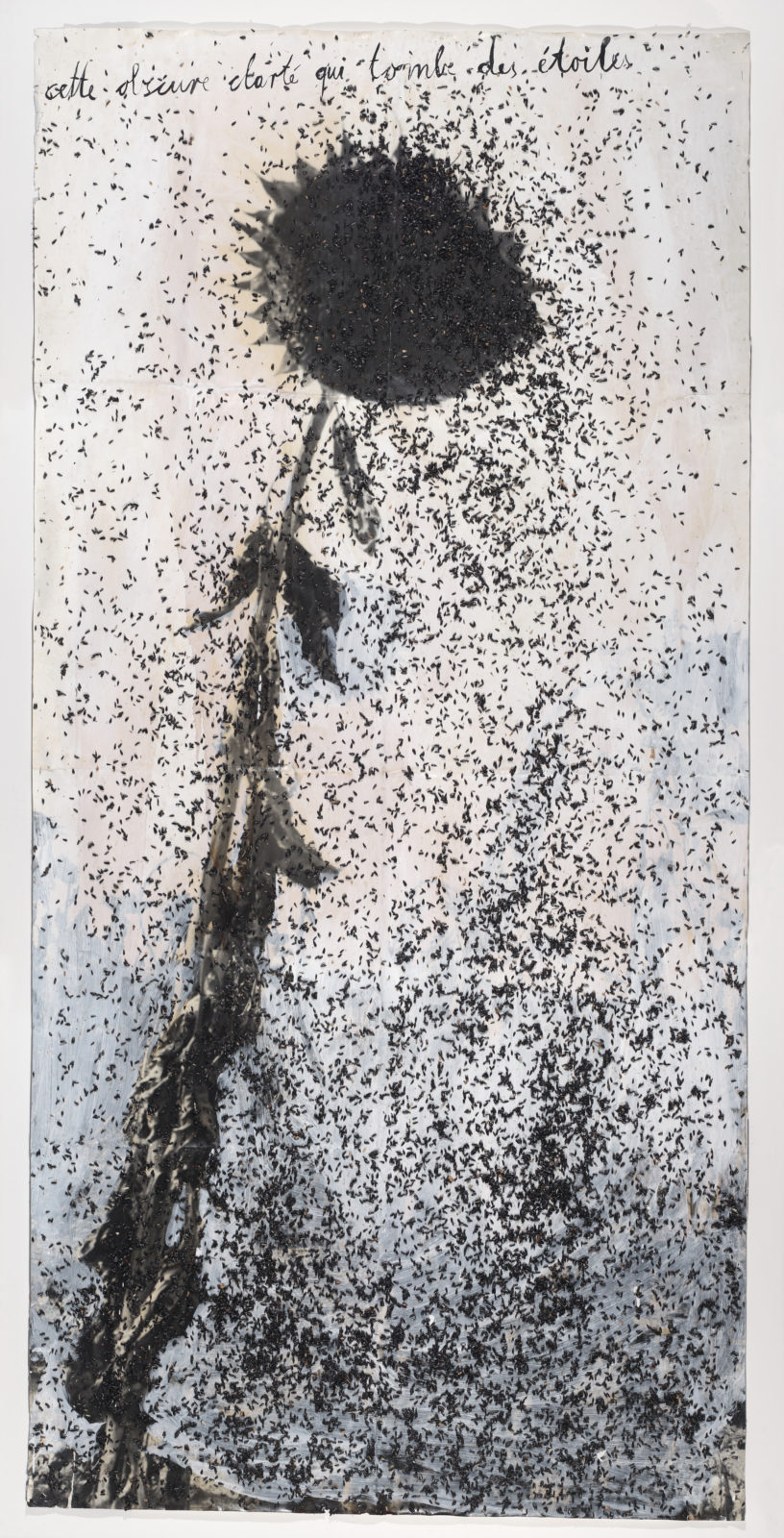
Anselm Kiefer, Cette obscure clarté qui tombent des étoiles, 1996
© Donation Yvon Lambert à l’État français / Centre national des arts plastiques / Dépôt à la Collection Lambert, Avignon
Christo, Valley Curtain, Rifle, Colorado, 1971
“In 1971, a first exhibition of Christo in the gallery was scheduled. A bit like the Land artists, Christo was going to measure himself against the elements, keeping his studio only to make the preparatory sketches of the works. My gallery was filled with all the documentation concerning one of the first monumental projects in nature: Valley Curtain. The couple’s obstinacy in defending their projects, the incredible energy displayed by Jeanne-Claude made us all want to help them in one way or another, selling works or giving contacts that could help find permissions that take so long to obtain. (…)

This drawing fixes in my memory our beautiful collaboration which made it possible, in a certain way, to give day to this first large-scale realization.”
Christo, Valley Curtain, Rifle, Colorado, 1971
© Donation Yvon Lambert à l’État français / Centre national des arts plastiques / Dépôt à la Collection Lambert, Avignon
Gordon Matta-Clark, Descending Steps for Batan (Rendez-vous, Sous-sol), 1977
“For our first collaboration, I wanted a specific work. It was only natural that Gordon suggested that I dig the gallery floor. We certainly had to be a little oblivious to implement such a project, but the more the date of the exhibition advanced, the more we were excited! (…) We have Gordon and I dug broken the cemented floor of the gallery then dug, dug for days. (…) After clearing the pieces of the destroyed soil, we discovered a cellar – which was actually mine and which I had never used, then with the picks and shovels, we continued to dig this hole until ‘at four meters deep. In the background, the bones of a cemetery in the old city lay on the ground. In this 50 cm2 hole, when I looked high, I couldn’t help but think that one of us was maybe digging his own grave. All the earth and the rubble brought to the surface constituted a veritable mountain in the cellar. It was absolutely spectacular. Yet neither the public nor the collectors were really there.”
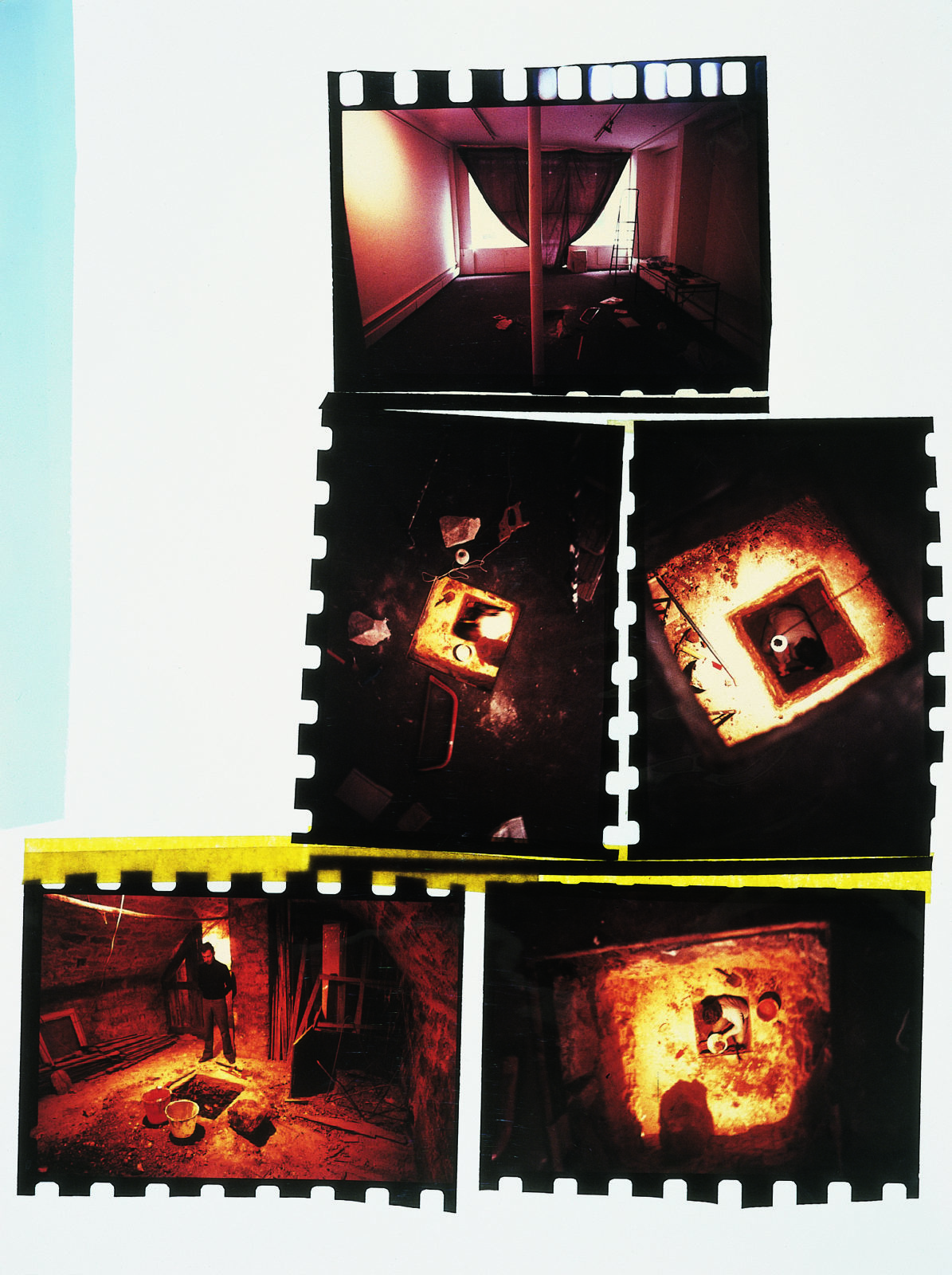
Gordon Matta-Clark, Descending Steps for Batan (Rendez-vous, Sous-sol), 1977
© Donation Yvon Lambert à l’État français / Centre national des arts plastiques / Dépôt à la Collection Lambert, Avignon
Carl Andre, Turf Yard, 1965
“Turf Yard and Bulk Cake are created according to a common process that allows us to understand the work of this artist. They combine the idea of an elegant poetic game with a kind of camouflaged little manifesto. (…)
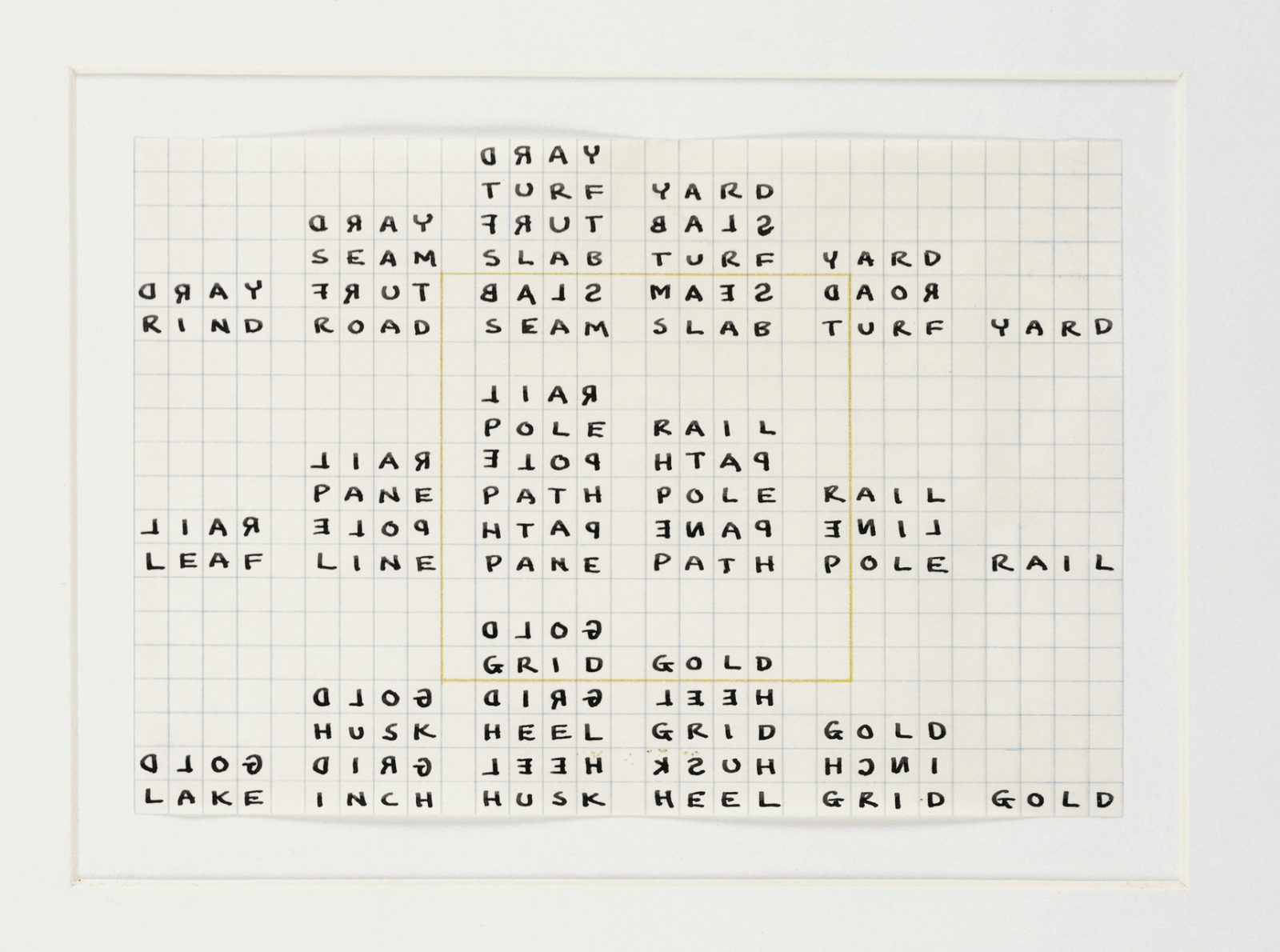
These poems are modulated on grid paper and become as visually fascinating as from a literary point of view. Like crosswords without their own definition, these are assemblies of letters that sometimes make up a word but that also may have no meaning. They extend box after box; upside down, the alphabet stretching, enriching itself with new forms.”
© Donation Yvon Lambert à l’État français / Centre national des arts plastiques / Dépôt à la Collection Lambert, Avignon
Andres Serrano, Rene, 1990
“The Nomads photographic series was my first encounter with Andres’ work. It was at the end of the 80’s, in a New York gallery, the Stux Gallery.
Immediately, I tell the friend I was traveling with that I wanted to exhibit this artist I didn’t know anything about yet. There had indeed been all the scandals that announced the wave of politically correct, with the wrath of the National Endowment for the Arts, furious to know that aid for creation could be used to defend works that the members of the commission considered obscene . But I admit that I discovered the work of Serrano, without being aware of the problems that Piss Christ may have caused.”

Andres Serrano, Rene, 1990
© Donation Yvon Lambert à l’État français / Centre national des arts plastiques / Dépôt à la Collection Lambert, Avignon
Lawrence Weiner, Ruptured, 1972
“This mural by Lawrence Weiner is simple to make. This ease of execution is also part of its aesthetic process. Had he not been the first artist to completely reinvent the very meaning and status of a work of art by saying that one of its pieces could be produced, could also not have been produced, or even produced by someone ‘another.
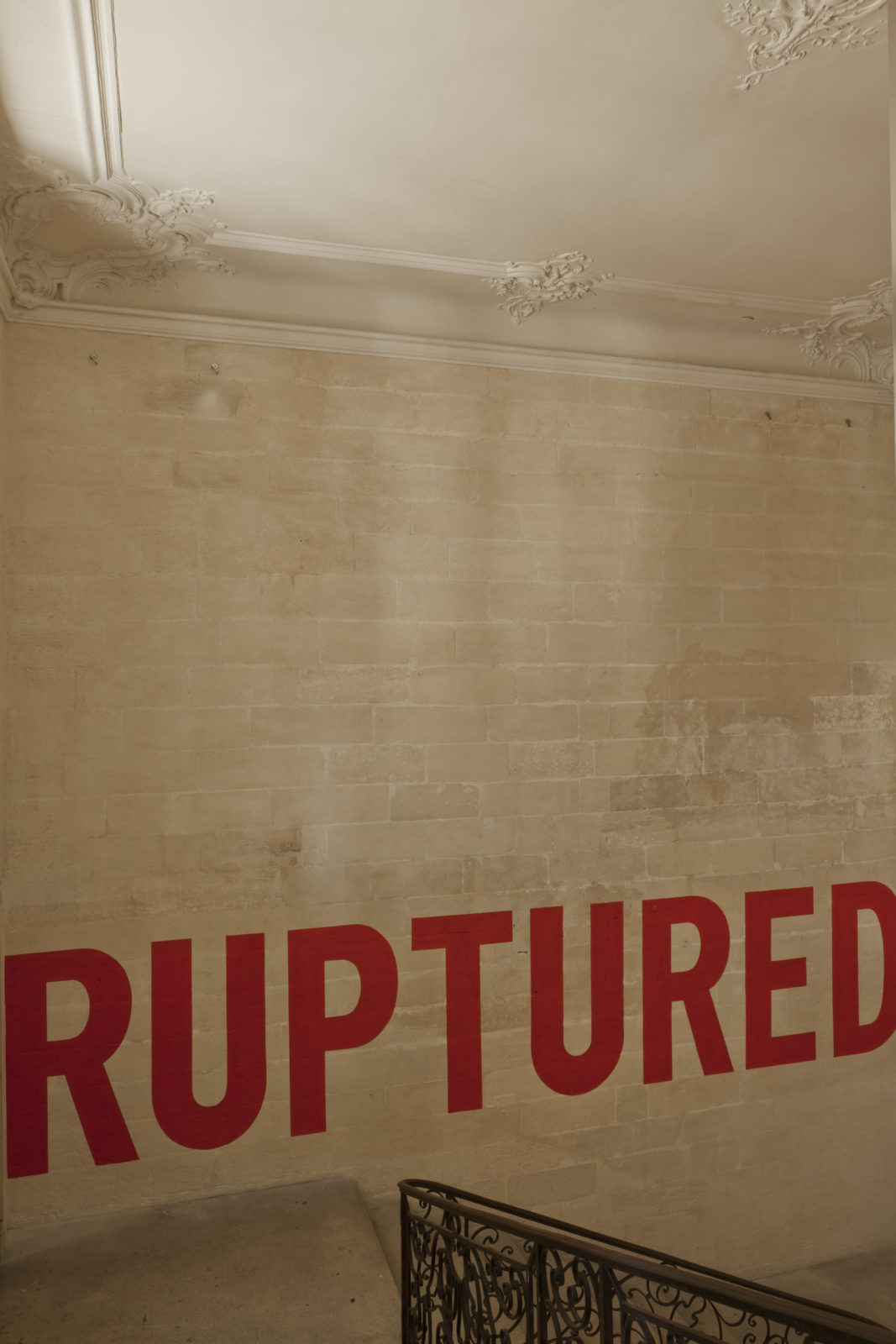
(…) To be faithful to the founding principle of the work, I did not wish to give directives as to how to paint this word on a wall. One can indeed use large adhesive letters, paint them with a stencil or even use a simple spray which one uses to repaint cars or to make graffiti on the subway trains.”
Lawrence Weiner, Ruptured, 1972
© Donation Yvon Lambert à l’État français / Centre national des arts plastiques / Dépôt à la Collection Lambert, Avignon
Jean-Michel Basquiat, She Installs Confidence and Picks Up His Brain Like a Salad, 1988
“I liked the raw energy of Jean-Michel’s work, the violence that emanated from it too. The use of colors. I discovered a new language which I particularly liked. But as often, it’s a whole that I appreciated. The works therefore, but also this boy as fanciful as determined and who loved to speak French. I would also say that I became fully aware of the extreme depth of his work in contact with him, by sharing privileged moments with him, listening to him, watching him work.”
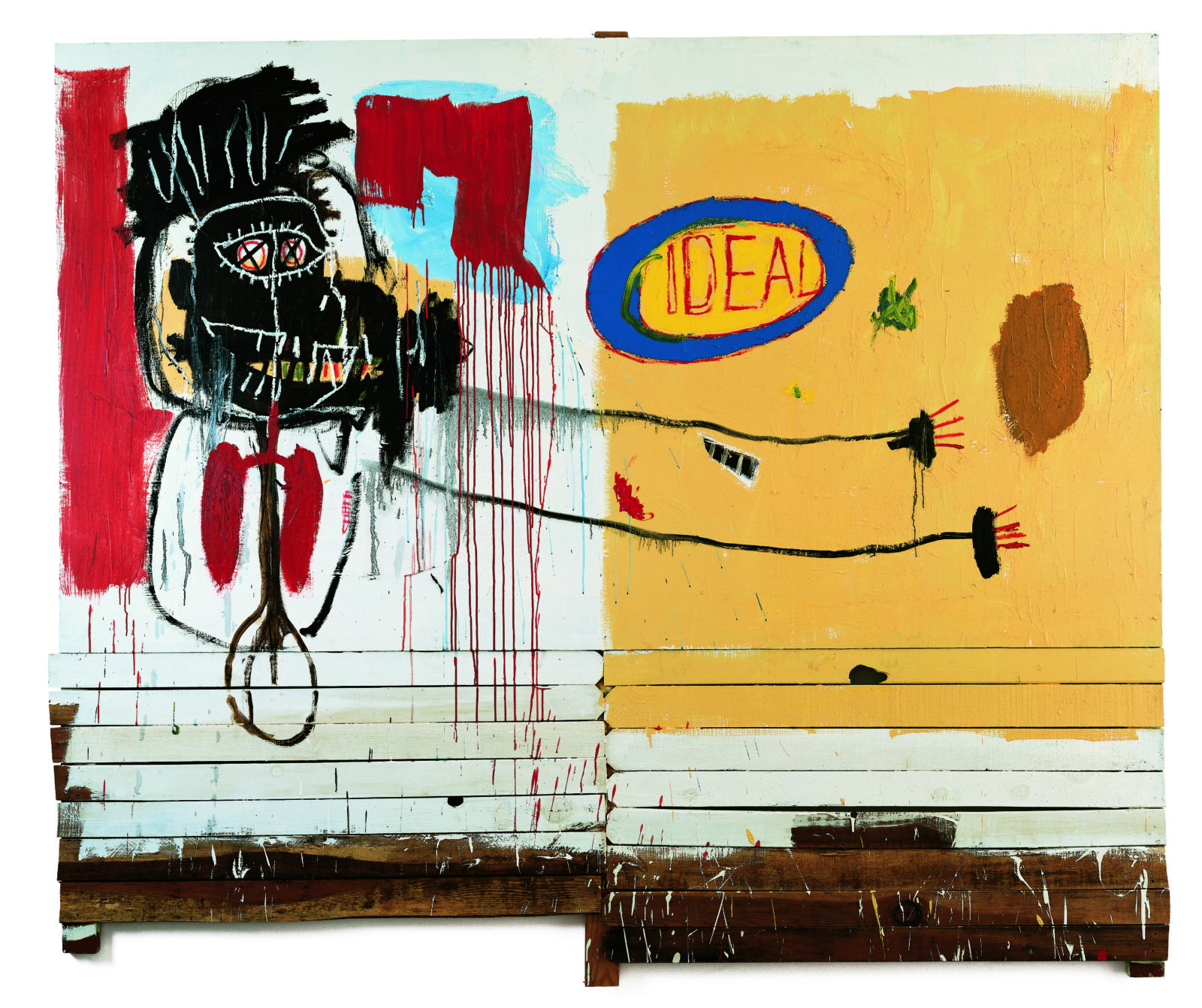
Jean-Michel Basquiat, She Installs Confidence and Picks Up His Brain Like a Salad, 1988
© Donation Yvon Lambert à l’État français / Centre national des arts plastiques / Dépôt à la Collection Lambert, Avignon
Sol LeWitt, Wall Drawing # 538, 1984-1988
“Something new in the way of producing art was happening with this generation of artists and it was in the United States that this revolution was happening. My interest in Sol LeWitt’s work was very instinctive. Like a love instinct, a new encounter that I did not want to pass up. I wanted to live this new adventure alongside these forms and these images that I discovered. […] The character also seemed to me to come to the art scene with a real speech. He was so smart. Let us remember his Paragraphs on conceptual art published in the famous magazine Art Forum in 1967! “

“This Wall Drawing is part of the great historical lineage of in situ works including Roman painters, then those of the Quattrocento had the secret to beautify villas and palaces. The technique is not far from that which prevailed to achieve the patinas of the rooms decorated by the great Italian fresco artists. Thus, after having recomposed the original drawing from the volumes offered, Sol LeWitt and his assistants traced on the walls the cutouts which will create these impressions of perspective which amplify the space. Then comes the very long and meticulous time when the juices of colors are passed to the cloth. It is the different color passages on the surface that give this depth and transparency so special.”
Robert Mangold, Distorted Circle Within a Square, 1972
“Robert Mangold is very secretive, but his works speak for themselves. They always chat discreetly with the artists in my collection. There are of course classical filiations that can be proposed between the drawings of Mangold and those of Ryman or certain works of Barry. Yet it is always Matisse that I think of when I contemplate precisely Distorted Circle Within a Square, a drawing which dates from 1972. (…) Between Mangold and Matisse, there is this same emotion probably aroused by the fragility of the lines, by the emotion that takes precedence over precision and the scale of the gestures contradicted, however, by the rather reduced format of the works.”
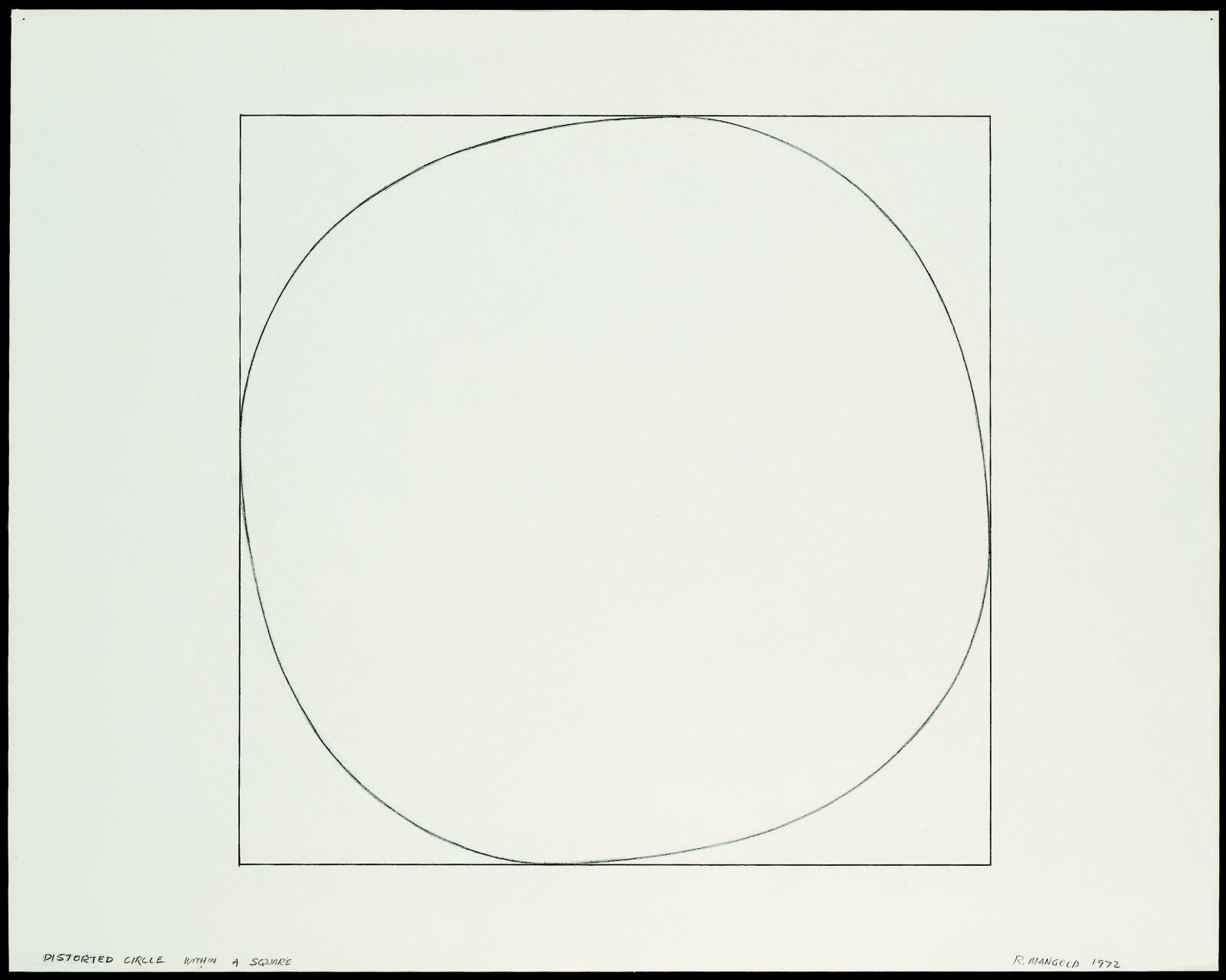
Robert Mangold, Distorted Circle Within a Square, 1972
© Donation Yvon Lambert à l’État français / Centre national des arts plastiques / Dépôt à la Collection Lambert, Avignon
Richard Long, Sculpture at Yvon Lambert, Paris, 1969
“This work is historically very important, and sentimentally, it again sets in my memories the beginning of the introduction of Land art in France. (…) For his first exhibition in my gallery, Richard arrived as usual with his backpack as the only traveling workshop and took out small bags of multicolored pigments. After having perfectly swept the floor of my first gallery, rue de l’Echaudé, he laid out each color like streaks of powder that were going to constitute a huge rainbow.
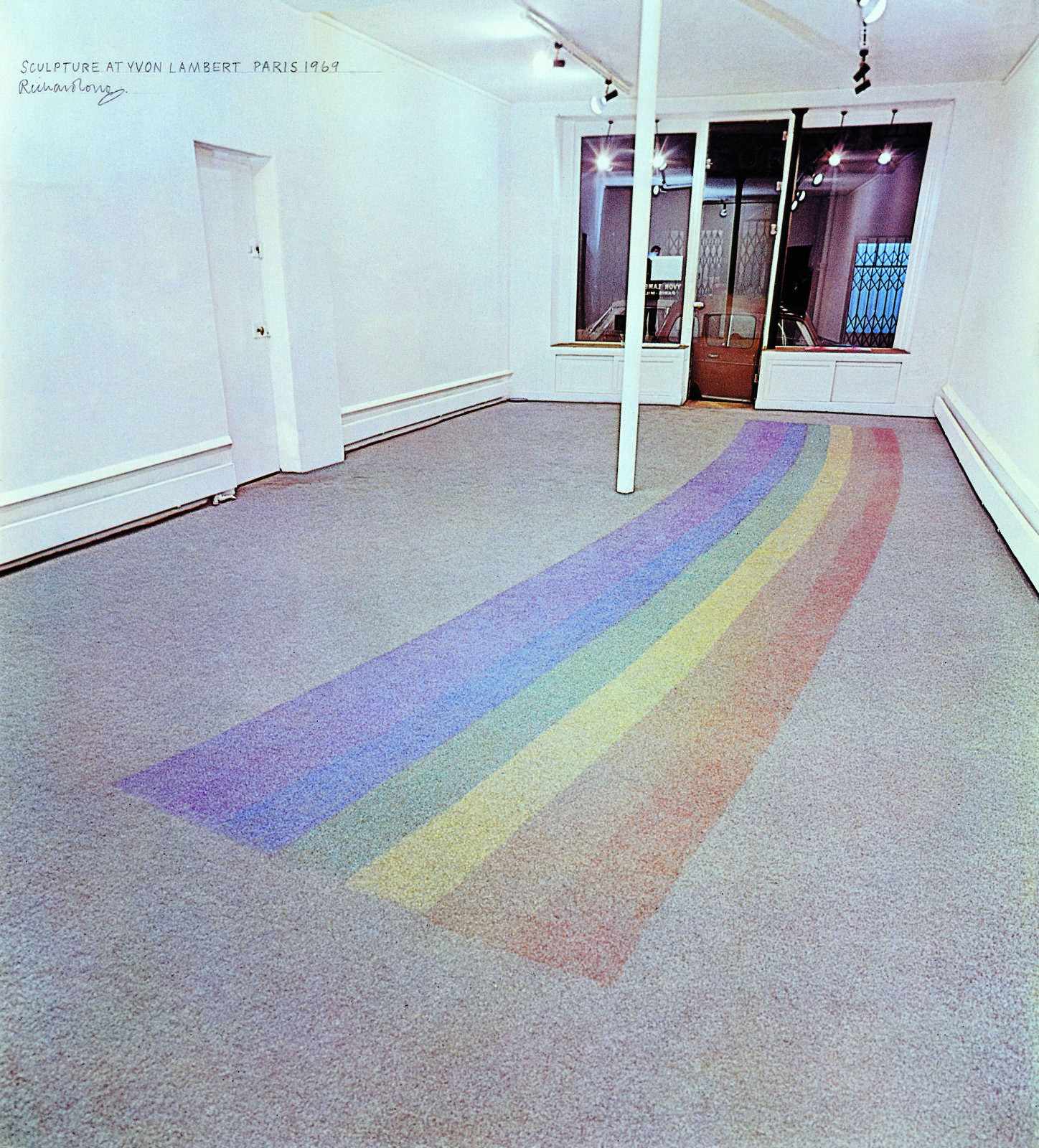
(…) Once his work was finished, Richard left the gallery and took this picture which he signed later when I decided to acquire this photograph as an observation of the work. If you take a good look at this photo, you can see Richard in the reflection of the window taking this photograph.”
Richard Long, Sculpture at Yvon Lambert, Paris, 1969
© Donation Yvon Lambert à l’État français / Centre national des arts plastiques / Dépôt à la Collection Lambert, Avignon
Rei Naito, Namenlos/Licht, 1996

“It was in New York that I discovered these two drawings. In my opinion they have the sensuality of those of Agnes Martin or Brice Marden. I admit that at first I thought I was in front of a white monochrome, then, very slowly, very slowly, the drawing came to me. Two red circles appear like a photographic work which in a final phase of creation develops progressively in the tank of the developer. The magic operated in me like an image which haunts the mind for a long time. The next day, my decision was made, I would go back to France with these two drawings.”

Rei Naito, Namenlos/Licht, 1996
© Donation Yvon Lambert à l’État français / Centre national des arts plastiques / Dépôt à la Collection Lambert, Avignon
Donald Judd
“If I have never done personal exhibitions of Donald Judd, his works have nevertheless been presented in my gallery and I have a very nice set of drawings and sculptures.
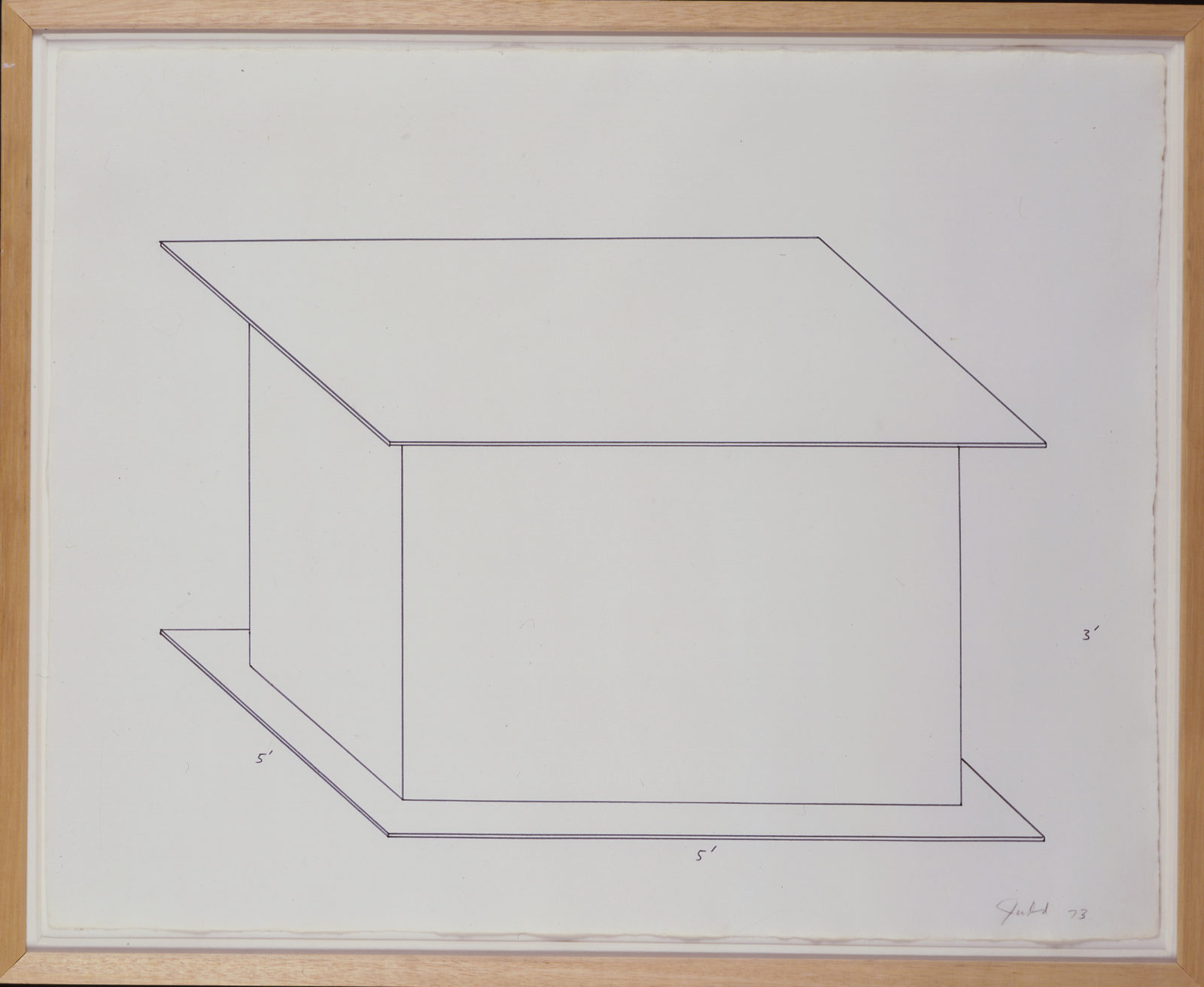
Whenever I go to New York to work and meet my artists, I went to see him in his workspace so central and essential. A real friendship has been born over the years. We had our cafes for our meetings, our places to walk around, like this bookstore that no longer exists today, Jaap Reitman, where we consulted and commented on new releases of art books. Regularly, during these quick stays, I bought him pieces that he showed me in his workshop, like this series of drawings that he was preparing and that I asked him to finish before my return to Paris.”
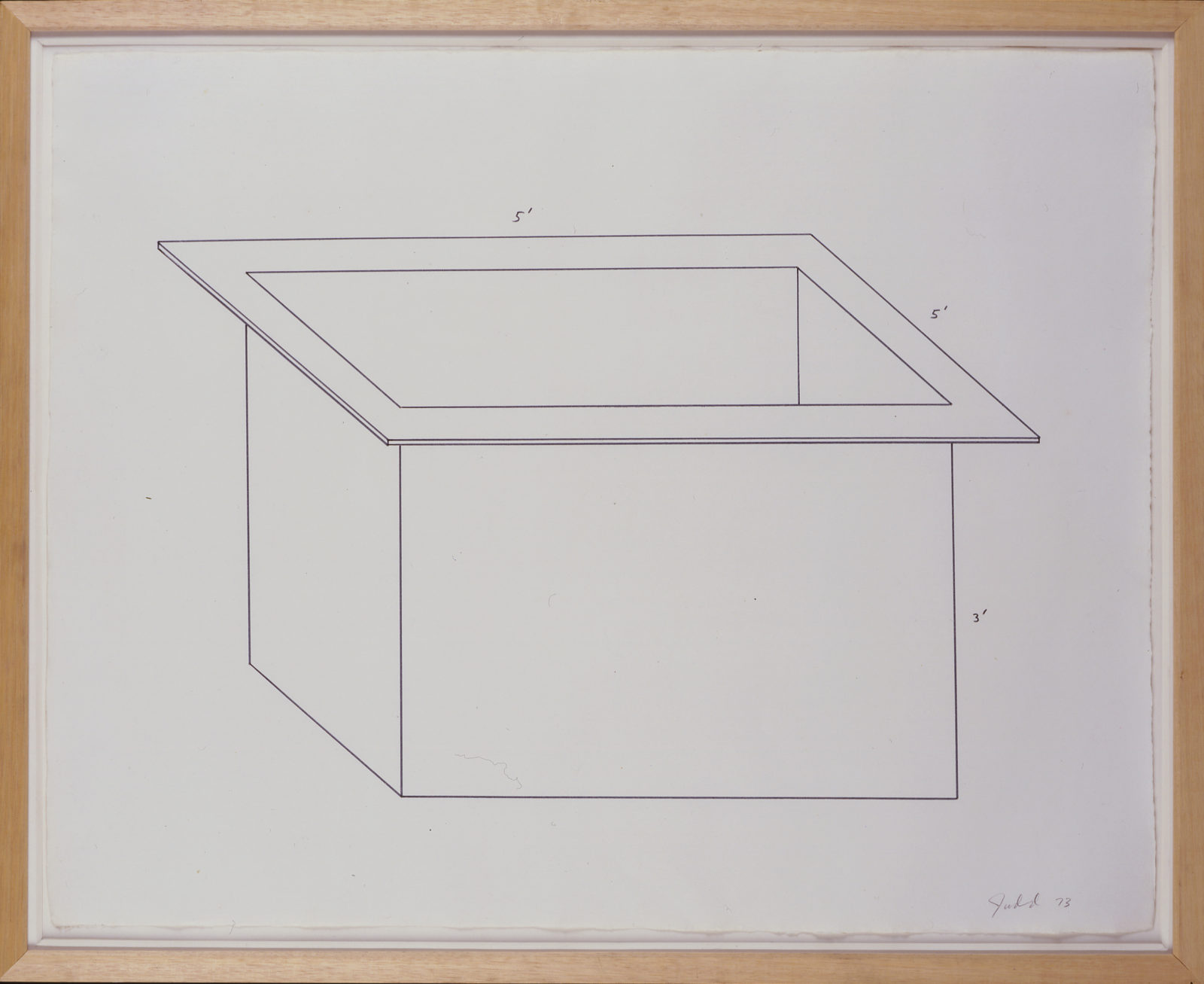
Donald Judd, Sans titre, 1973
© Donation Yvon Lambert à l’État français / Centre national des arts plastiques / Dépôt à la Collection Lambert, Avignon
Daniel Buren, De la peinture – Une Œuvre en douze parties, 1969-1973 (détail)
“[My meeting with Daniel Buren in 1968] was very strong. I was then truly dazzled by [his] intelligence. I bought some of his works as early as 1969. We organized several exhibitions, totally unsellable, of course. […] We debated a lot among ourselves, as well as with Michel Claura and René Denizot, but there were few battles around his work because it aroused interest only with rare visitors. I like controversy, and I wished I could argue more then. I also liked the paradox of exhibiting unsaleable works in a commercial gallery.”

Daniel Buren, De la peinture – Une Œuvre en douze parties, 1969-1973 (détail)
© Donation Yvon Lambert à l’État français / Centre national des arts plastiques / Dépôt à la Collection Lambert, Avignon
Bernard Faucon, Les petits bateaux, 1980
“In 1991, I decided to offer him my space after seeing the whole series of Idols and Sacrifices. I liked these photographs a lot. There was for example the bust of a young boy lit by fire, and bloodstains which recalled all the tragic stories of antiquity, from the Titan devouring his children to Medea who, drunk with jealousy, sacrificed his own for revenge, abandoned by the one she loved. It was the brutality of these images that fascinated me. Once the era of somewhat distant models was over, he devoted himself to uncompromising hand-to-hand combat with death and endless flowing blood. After this violence came the lull with messages that Faucon wrote on the skin of young adolescents, always animated by his strange approach to childhood and its representation by images …”
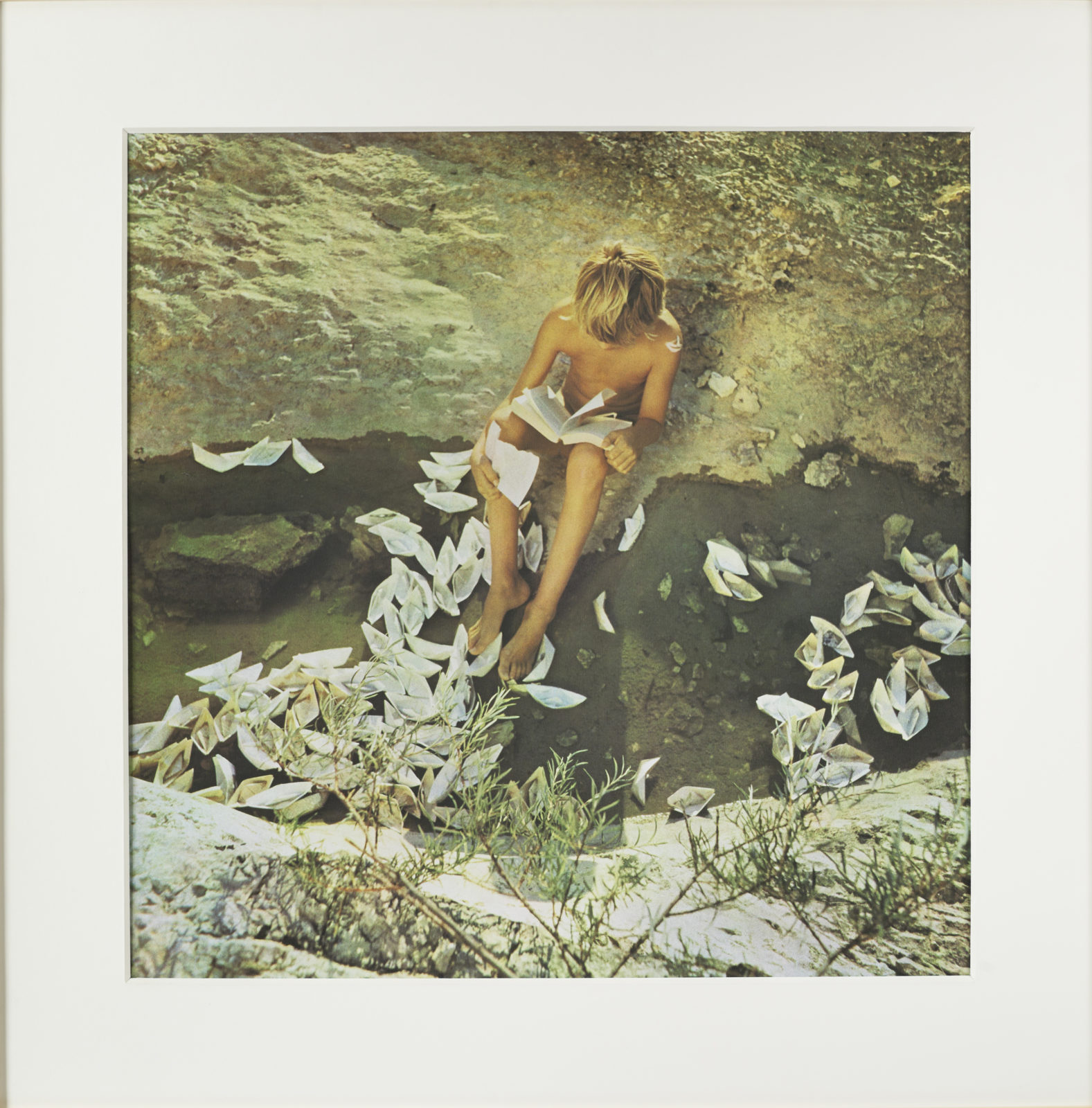
Bernard Faucon, Les petits bateaux, 1980
© Donation Yvon Lambert à l’État français / Centre national des arts plastiques / Dépôt à la Collection Lambert, Avignon
Jean-Charles Blais, Assis encore, 1982
“As Jean-Charles reminds me today, I took a little time to determine myself, wanting to discover this boy who often spent dialoguing with me in the gallery and who proved to be intelligent, refined, with a real personal culture . Although what I was exhibiting was radically opposed to this figurative painting, I knew that Jean-Charles wanted me to represent it at home. One spring afternoon, in 1982, Bernard Lamarche-Vadel who was in his workshop called me, saying that if I didn’t make up my mind quickly, Jean-Charles could contact other merchants who, feeling the wind coming , were starting to woo him. As it is often the best way to stimulate myself a little, I made an appointment on the hour and left home with a first series of drawings purchased in two minutes, and a date for his first exhibition. I just said to him, “Will you be ready in two months?” And he replied “yes”, too delighted that such haste would allow him to finish a whole series of beautiful works.”

Jean-Charles Blais, Assis encore, 1982
© Donation Yvon Lambert à l’État français / Centre national des arts plastiques / Dépôt à la Collection Lambert, Avignon
Cy Twombly, Nike, 1980 (détail)
“[Twombly’s work] certainly represents the most accomplished and consistent set of all the artists that make up my personal collection today.”
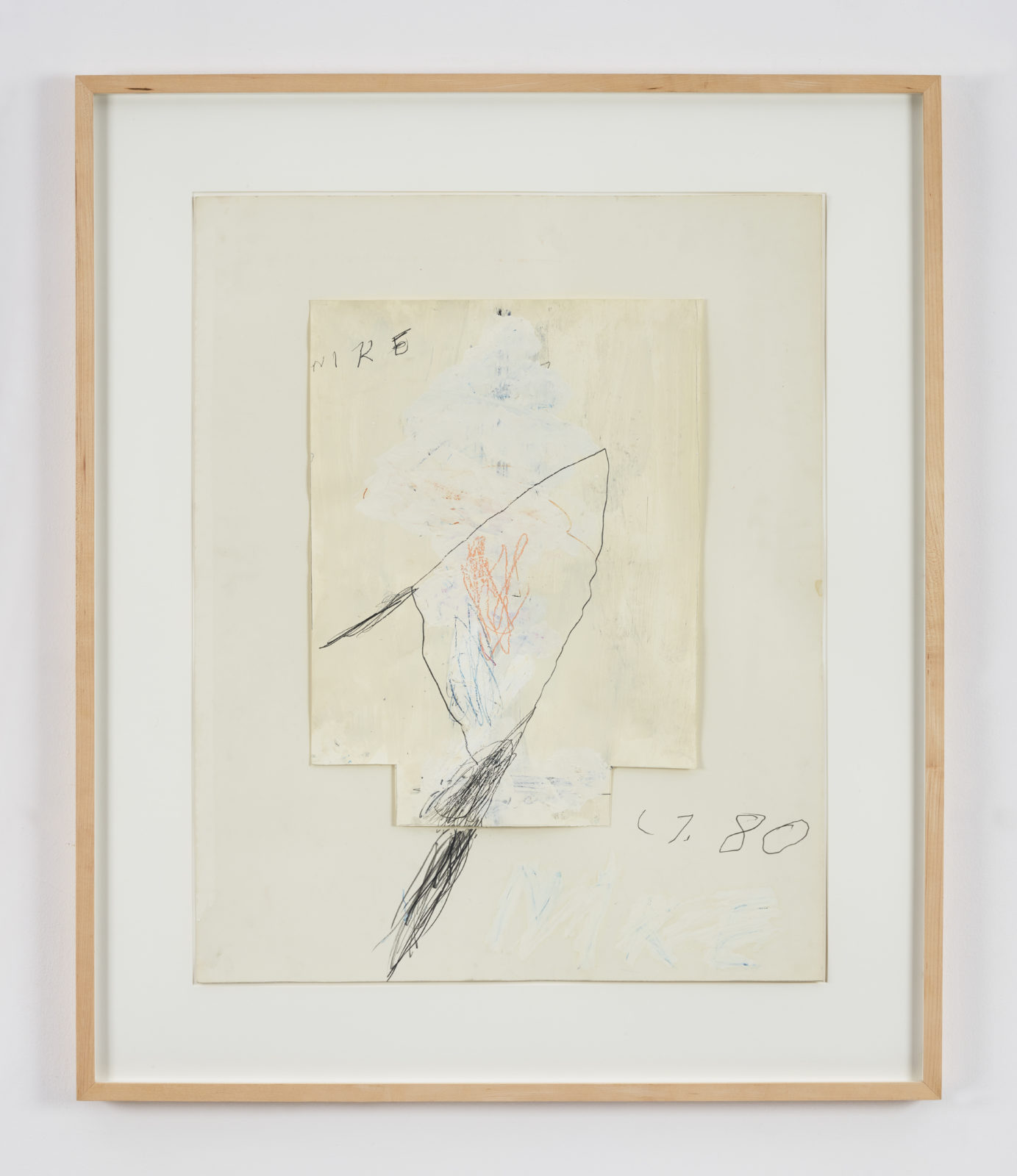
Cy Twombly, Nike, 1980 (détail)
Crédit photo : François Deladerrière
© Donation Yvon Lambert à l’État français / Centre national des arts plastiques / Dépôt à la Collection Lambert, Avignon
Shusaku Arakawa, Sans titre, 1969
“Arakawa practices a kind of understatement by doing the least, to say the most. White canvases with some traces evoking the technical diagrams of an engineer or an architect, often inscriptions in a printing letter such as: “I decided to leave this canvas completely white”. He takes the spectator, accustomed to the images to be deciphered, into the trap of his empty spaces. His inscriptions provoke him, get him out of his indifference and lead to his “participation”. In this spontaneous generation of Duchamp’s children, Arakawa had a special place in adopting this idea of the viewer who paints the picture. In my opinion, this is the key to understanding the genesis of the conceptual movement that I was going to defend during the 1970s.”
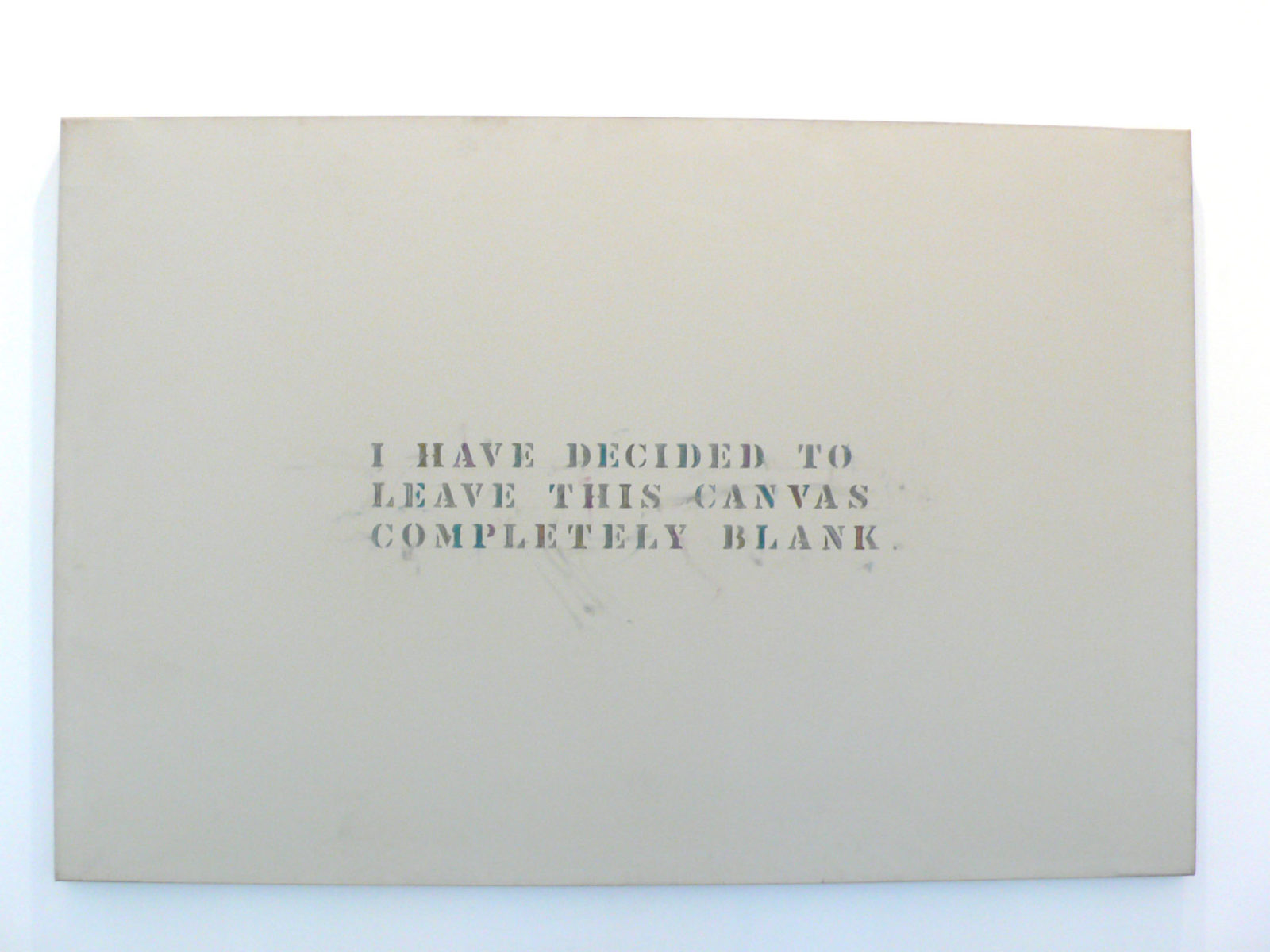
Shusaku Arakawa, Sans titre, 1969
© Donation Yvon Lambert à l’État français / Centre national des arts plastiques / Dépôt à la Collection Lambert, Avignon
Marcel Broodthaers, Chère petite sœur, 1973
“During these few years, I realize that I have managed to constitute a real set of works by Broodthaers. These paintings, sculptures and drawings are therefore a reflection of our friendship.”

Marcel Broodthaers, Chère petite sœur, 1973
© Donation Yvon Lambert à l’État français / Centre national des arts plastiques / Dépôt à la Collection Lambert, Avignon
